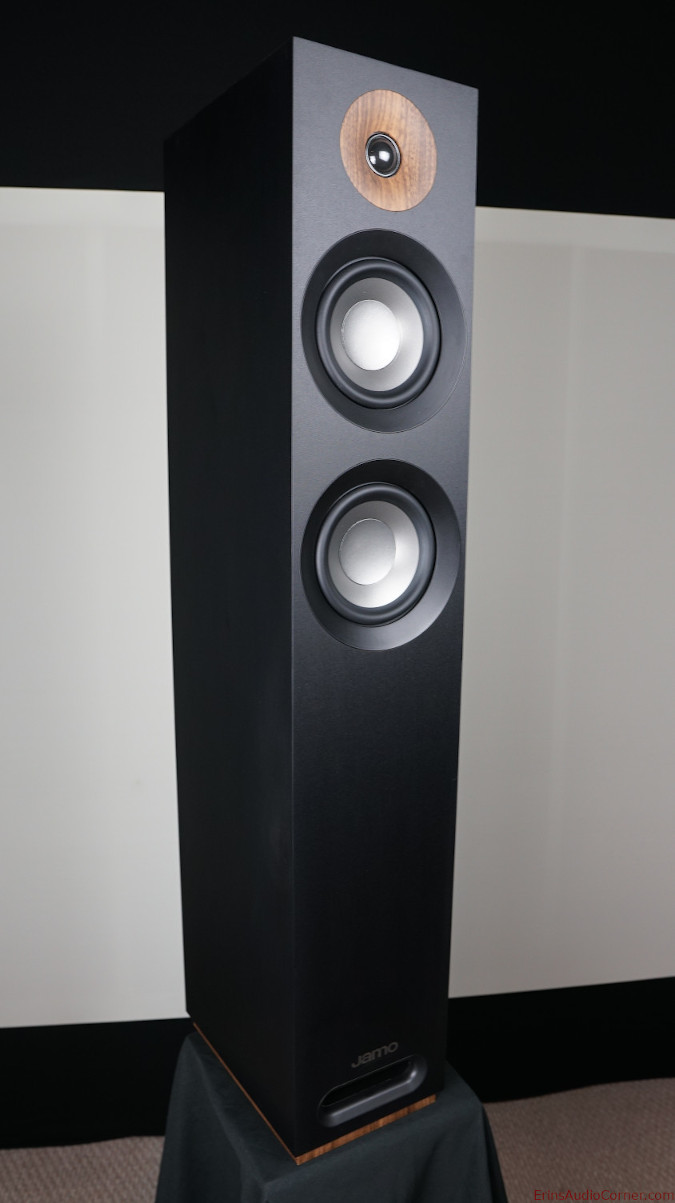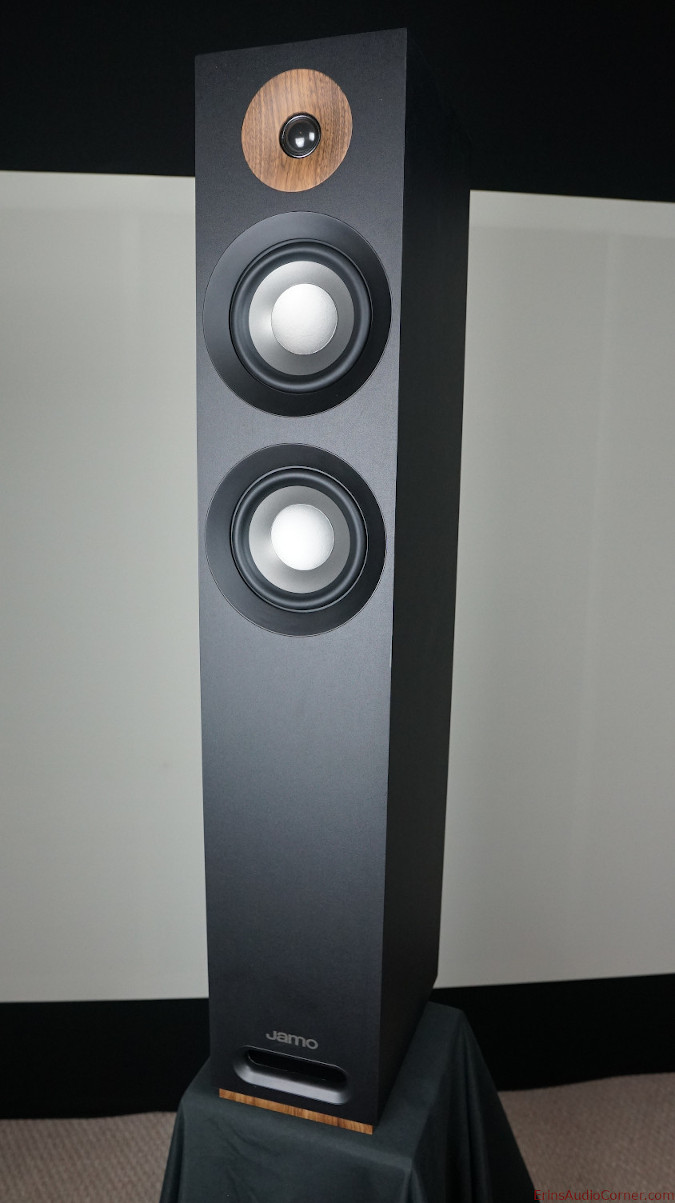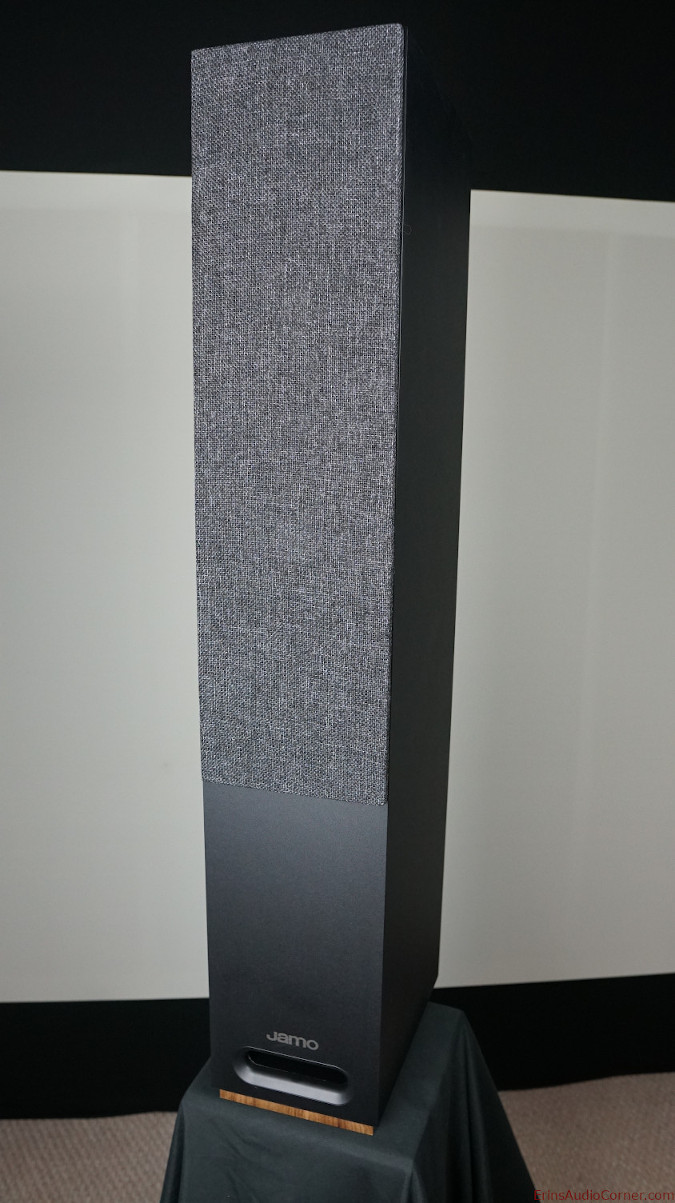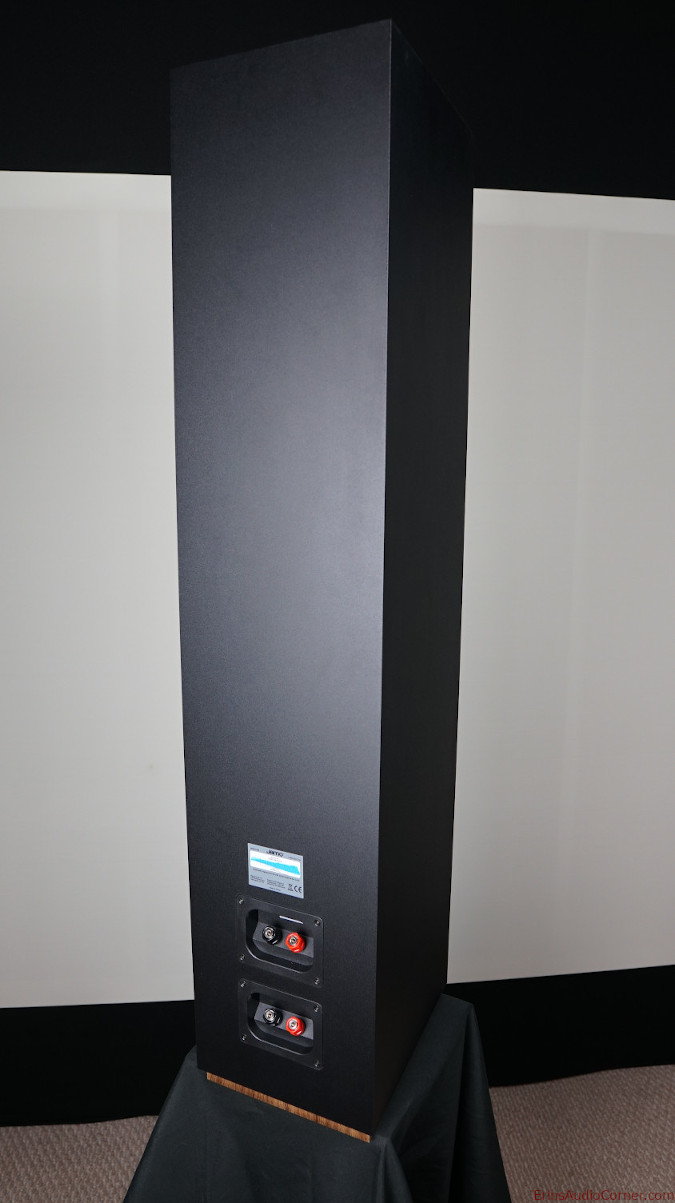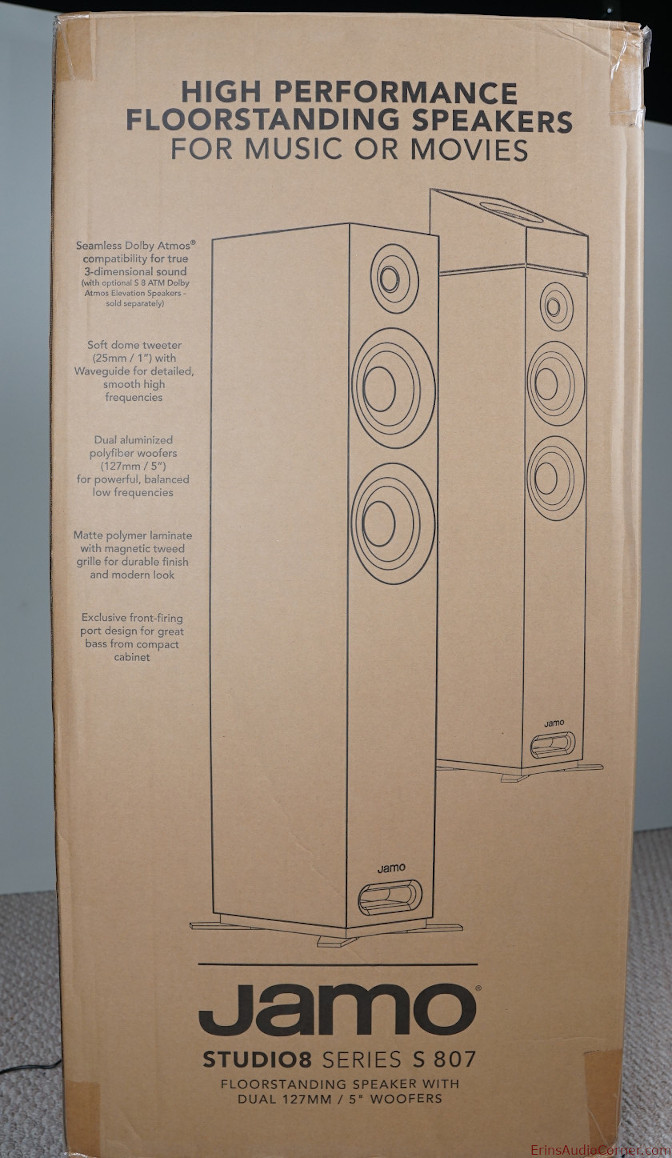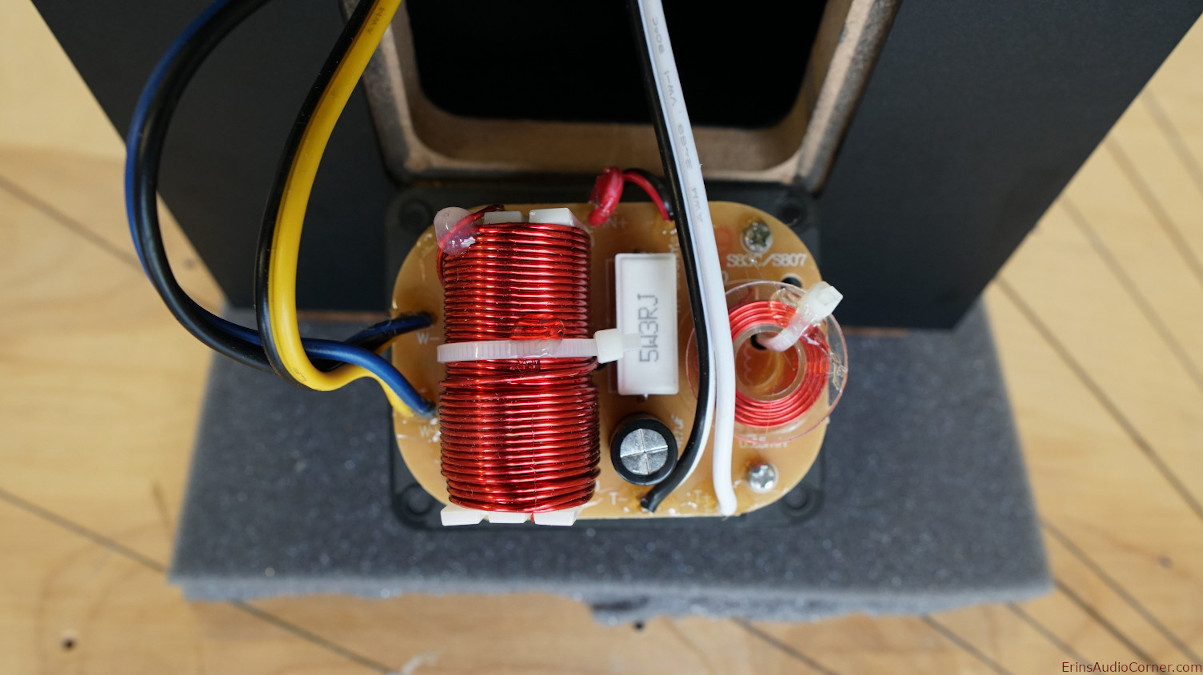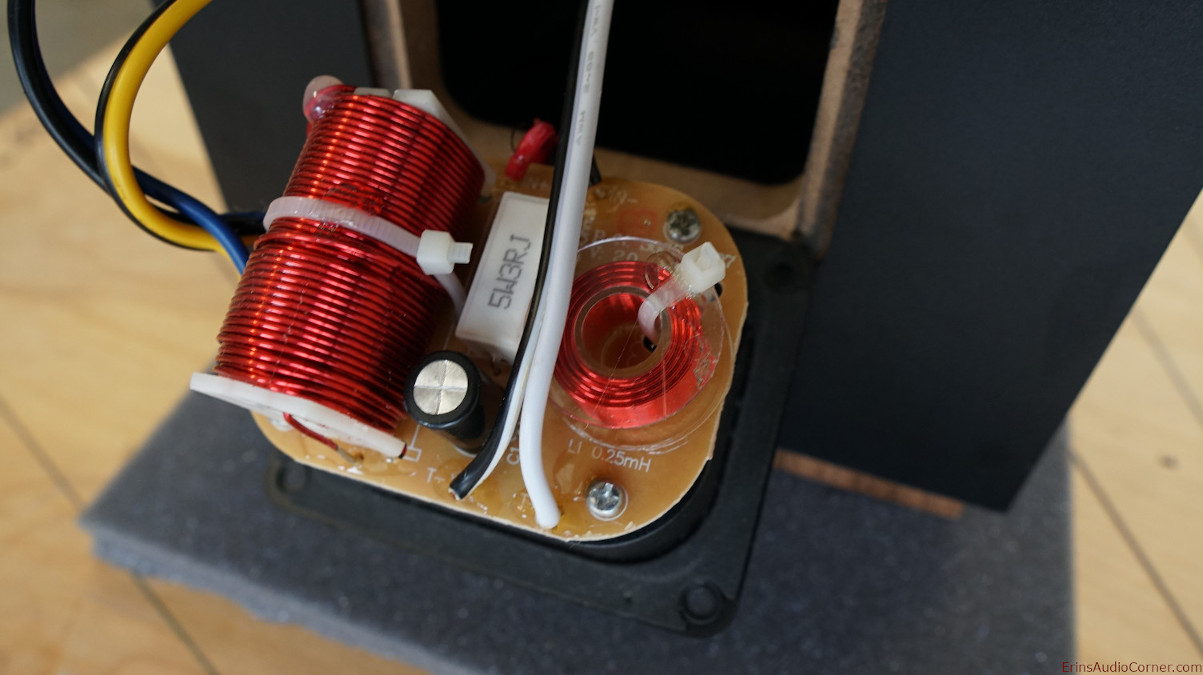YouTube Video Review version:
Intro
First off, I’ll just save you a lot of trouble if you’re a casual reader or someone wanting to know if they should buy these speakers for budget friendly hi-fi stereo use: Do not buy these speakers. They’re not good.
Update: Over the past month since this review was posted I’ve gotten a lot of people saying “what did you expect for $280”. People seem to miss the point that while these are indeed “cheap” speakers, you should expect more. Aside from having terrible linearity, the box claims a +/-3dB response window that just is not accurate. At all. This is my biggest gripe. People are paying for something they are not getting. Not even remotely. Companies should easily be able to provide better response “out of the box” than this and you can then tailor to your needs. /update
The reason I chose this speaker for review is simple: I was hoping to find nice performance on a relatively small sized tower speaker that is typically < $300 for the pair (and occasionally < $200/pair). One that just really punches above its class subjectively and objectively. You know… a diamond in the rough. Knowing Jamo is owned by Klipsch, I was a bit torn on what to expect. Looking around, Jamo is historically known as a high-quality brand. But that is not so true in present day. Klipsch has the reputation of producing “bright” speakers but I was hopeful that since this wasn’t the typical horn/waveguide Klipsch speakers use that it might not have those Klipsch traits few are fond of. Then I could feel confident in telling folks to buy it and I might make $10 this month to help cover my dinner one night if their purchase is made through my Amazon affiliate link. Unfortunately, this speaker is a poor performer and I cannot recommend it.
I’m seeing reviewers give these 4/5 stars. I don’t understand how. I guess they just want to sell speakers through their affiliate links or the like. I can’t imagine any other reason why someone would recommend these for general listening, home theater or hi-fi purposes. These speakers are What I heard from the get-go was bad and what I saw in the data was even worse. I know it is hypocritical to tell you to ignore others’ positive (subjective) reviews and trust my negative review but I can back my reasons up with data and will do so in this review.
If you’re looking for a home theater speaker specifically then you want something which produces dialogue well. Human speech is in the 200-6000Hz range but more typically emphasis is placed on the 500-4kHz region. The Jamo S807 has a boosted low-midrange and treble which basically puts the dialogue frequency range about 3-5dB lower than the rest of the frequency spectrum. Meaning, speech intelligibility with these speakers is low. So, great… not only is this a poor hi-fi speaker but it is a poor home theater speaker. For the same reasons. And therefore, helping to prove that there is no speaker goal that is better for one or the other. But that’s a different topic.
At any rate, if you want to go through Amazon here is my affiliate link for the Jamo S807 speaker. You can glance at the product page, the reviews and maybe purchase something else instead if you want to help me out. But to make it clear: Do not waste your money on this speaker for hi-fi stereo purposes. Maybe for just some movie speakers in your living room but I can’t really recommend that even at their low price point. Not unless you like punchy-only bass and extremely bright treble.
Foreword: Subjective Analysis vs Objective Data (click for more)
If you have seen my past reviews, you know that I am of the mindset that objective data is at least as important as someone's subjective evaluation of a speaker. If not more. Why? Because every room is different. Every listener is different. Some know what to listen for. Others know what they want to hear based on their own preference (i.e., some prefer extended bass, some prefer more midbass punch between 120-150Hz, some prefer a response with a dip around 4kHz, etc., etc.). What one person wants or expects may be opposite of another. Additionally, the room will impact the performance and therefore what the listener hears. This means when you read another's subjective-only review you are left to resolve those variables on your own. That's not likely to happen. Unless there is objective data you can use to get an idea of the performance. With objective data you can begin to understand why the subjective review turned out the way it did. Notably, objective data keeps reviewers honest. It's hard for a reviewer to legitimately bash one product but elevate another when the two measure practically the same in every regard. Not to say two similarly measuring speakers cannot subjectively sound different. Though, odds are if they do measure the same then a huge subjective difference is most likely attributed to other issues such as setup conditions, bias, etc. Objective data is the key to accountability. Simply put: if the measurements are taken with care and you understand them, you can rely on data to help paint a more accurate description of performance than a few adjectives from your favorite reviewer (myself included). As you will see, objective measurements can provide a lot of insight in to how the speaker will perform in your room.However, when possible, it is always best to demo speakers in your own room. Not simply because of subjective performance. But because of other factors such as aesthetics, pride of ownership, etc. In my experience, all these factors play in to how the listener “connects” with the system. A good shop or manufacturer understands this and allows buyers to try items out at home before purchasing or they offer a reasonable return policy. If you question the performance and can demo the speakers in your own home I suggest you take advantage of the opportunity.
For all the reasons listed above: What I provide here is objective-heavy analysis. I still provide my own subjective experience but with in-room measurements at my listening position(s) so we can understand why I heard what I heard. Is it the room, the actual speaker itself, my brain, or a combination?
Now that you understand my motives, let’s get started with the review.
Product Specs and Photos
I ordered this pair from Amazon. I purchased the black baffle with the woodgrain-finish tweeter “waveguide” version because that was the cheapest version at the time (for some reason the white version is 2x more expensive but is the same mechanically). I say “waveguide” because, while the tweeter assembly does have a smoothed, parabolic face, there’s not much wave-guiding going on here. The guide is really shallow and the tweeter dome sticks out nearly as high as the baffle face. This waveguide isn’t very effective. And I feel like calling it a waveguide is misleading. But that same token applies to countless tweeters in the retail and DIY market.
The speakers do come with a gray, tweed grille which magnetically snaps into place. Aesthetically, I prefer the speaker with grilles on. But, as you’ll see later, the performance is better without the grilles.
Grille On:

Crossover
Objective Data
Unless otherwise noted, all the data below was captured using Klippel Distortion Analyzer 2 and Klippel modules (TRF, DIS, LPM, ISC to name a few). Most of the data was exported to a text file and then graphed using my own MATLAB scripts in order to present the data in a specific way I prefer. However, some is given using Klippel’s graphing.
Impedance Phase and Magnitude:
Impedance measurements are provided both at 0.10 volts RMS and 2.83 volts RMS. The low-level voltage version is standard because it ensures the speaker/driver is in linear operating range. The higher voltage is to see what happens when the output voltage is increased to the 2.83vRMS speaker sensitivity test.
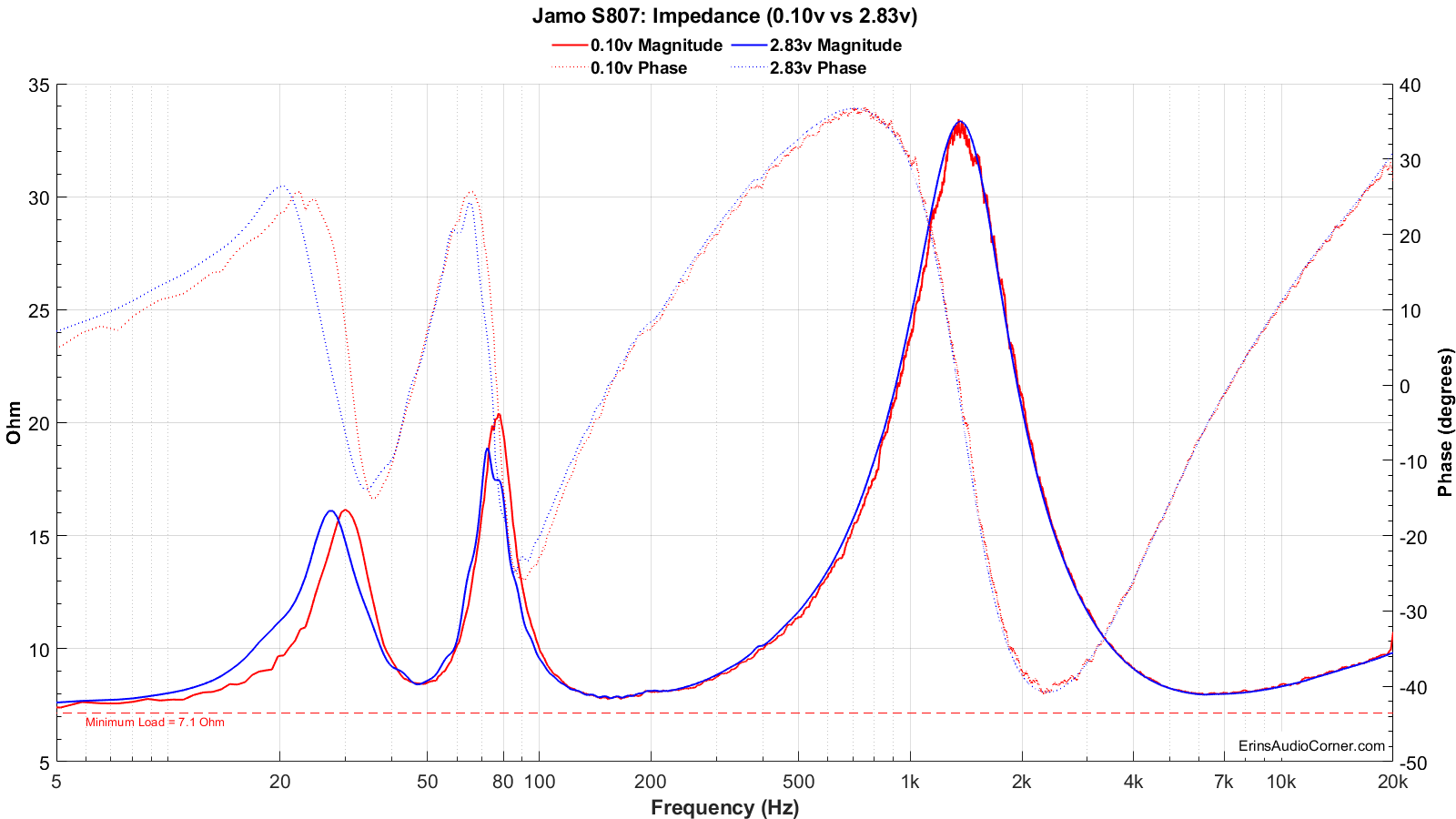
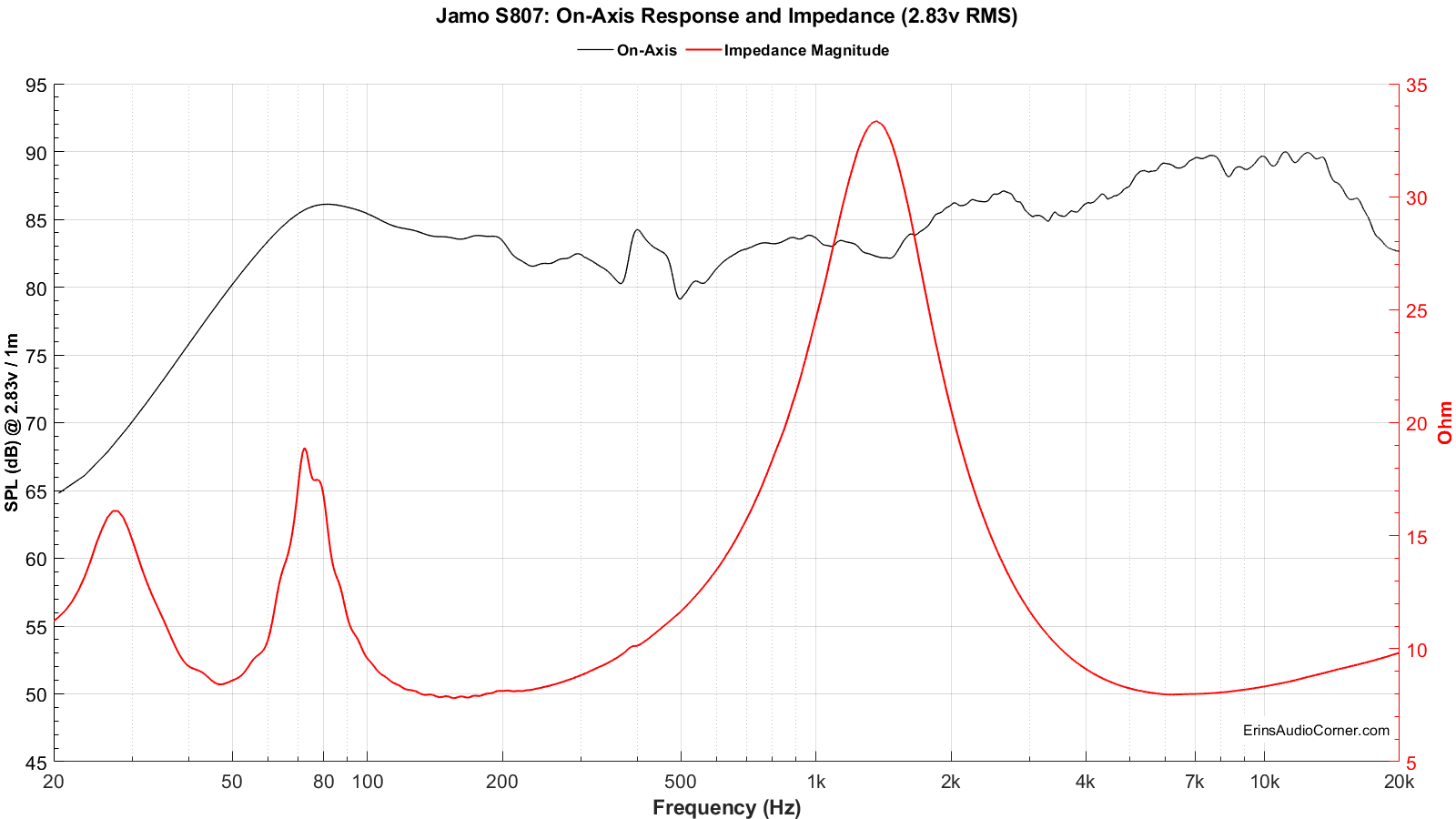
From the above data we can see the following:
- The tuning frequency of the enclosure is approximately 44Hz
- The minimum impedance dips to about 7.1 Ohms but at about 5Hz (the graphic cuts this off). Above this, however, the minimum load is approximately 8 Ohms throughout. This speaker’s load is easy for most any AVR to power without issue.
- There are numerous areas of concern in the impedance, represented by wiggles/bumps in the impedance curve. For example, there is a slight bump just below 400Hz. This typically signals a resonance of some sort (drive-unit basket, enclosure, port, etc.). You’ll notice the frequency response also shows a large resonance at this approximate frequency. These two are likely linked. There are also some wiggles between 100-200Hz that could indicate issues as well.
Frequency Response:
Notes about measurements (click for info)
Frequency response data (horizontal, vertical, “Spinorama”, polar, spectrograms, etc.) are all based on a 2.83 volts RMS logarithmic sweep at 1 meter to meet the standard sensitivity measurement spec. These data are captured using Klippel’s TRF module and a mixture of ground-plane measurement and 4-pi free-field measurement. Klippel’s In-Situ Room Compensation (ISC) module is then used with the ground plane measurement to provide a ‘reference’ curve to the 4-pi measurement which then corrects for the room’s influence and allows me to generate a reflection-free far-field response from an indoors measurement. Note: This is not a standard merge of nearfield and farfield nor a merge of ground-plane and farfield. Typical merged responses still suffer low resolution in the midrange where the response is merged due to the necessity of windowing the impulse response to remove reflections. One major downside to “gating” or “windowing” the impulse response is this low-resolution does not show resonance in the midrange. For example, most free-field measurements are only reflection-free until approximately 3 milliseconds, or about 300Hz. That means a data point every 300Hz. If you have a high-Q resonance at 450Hz the 300Hz resolution data will not show this resonance because the frequency resolution only has a data point at 300Hz and 600Hz; skipping right over the 450Hz. You would need a resolution of at least a half the width of the Q-factor; generally, 20Hz is adequate. However, 20Hz resolution is roughly 50ms of window-free response. The only way to achieve this is in a large parking lot or open field. Ground plane measurements are perfect for this but are subject to aiming/ground absorption (grass) and related issues above 400Hz. The ISC module permits results with as-close-to-anechoic as one can achieve without being anechoic. Thanks to the ISC module, the data I am providing here is higher resolution (~30Hz resolution) than an average person can provide without access to an anechoic chamber or the like.
The measurement below provides the frequency response at the reference measurement axis - also known as the 0-degree axis or “on axis” plane - in this measurement condition was situated in-line with the tweeter (I could find no directions in the online manual to listen at any other axis). The grille was off for these measurements. I do have comparison data of the grille on vs off in my Miscellaneous section below.

The mean SPL, approximately 84.2dB, is calculated over the frequency range of 300Hz to 3,000Hz. Jamo claims the sensitivity is 90dB at 2.83v/1m. The only way this would be accurate is if this sensitivity value was taken above 7kHz.
The blue shaded area represents the ±3dB response window from my calculated mean SPL value. As you can see in the blue window above, the Jamo S807 has a ±3dB response from 53Hz - 5kHz but only if you ignore the dip in response between 350-600Hz. Jamo claims a ±3dB window of 42Hz - 26kHz. Obviously, their value is incorrect. A tighter window of linearity is provided in gray as ±1.5dB from the mean SPL. But this speaker doesn’t stay within this range at all. Overall, this speaker’s on-axis response linearity is abysmal.
The speaker’s F3 point (the frequency at which the response has fallen 3dB relative to the mean SPL) is 53Hz and the F10 (the frequency at which the response has fallen by 10dB relative to the mean SPL) is 37Hz. Even though this speaker does sport (2) 5-inch mid/woofers they simply aren’t enough for extended bass. While typical rooms provide a low-frequency boost, if you plan to listen to music with lower frequency content, this information indicates you would need a subwoofer to fill in the lower octaves (or, you can use EQ to boost the low end but lowering the maximum SPL).
This is the first speaker I have tested with such a wild variation in frequency response. The response curve looks like a smiley face: lows and highs but no midrange. This will probably grab people’s attention and to those who don’t know what a high-fidelity speaker should sound like it may sound awesome: it grabs your attention with the bass bump around 80Hz and with the overly exaggerated high frequency response. But after a couple minutes you begin to realize just how bad it is.
Below are both the horizontal and vertical response over a limited window (90° horizontal, ±40° vertical). I have provided a “normalized” set of data as well. The normalization simply means that I took the difference of the on-axis response and compared the other axes’ measurements to the on-axis response which gives the viewer a good idea of the speaker performance, relative to the on-axis response, as you move off-axis.

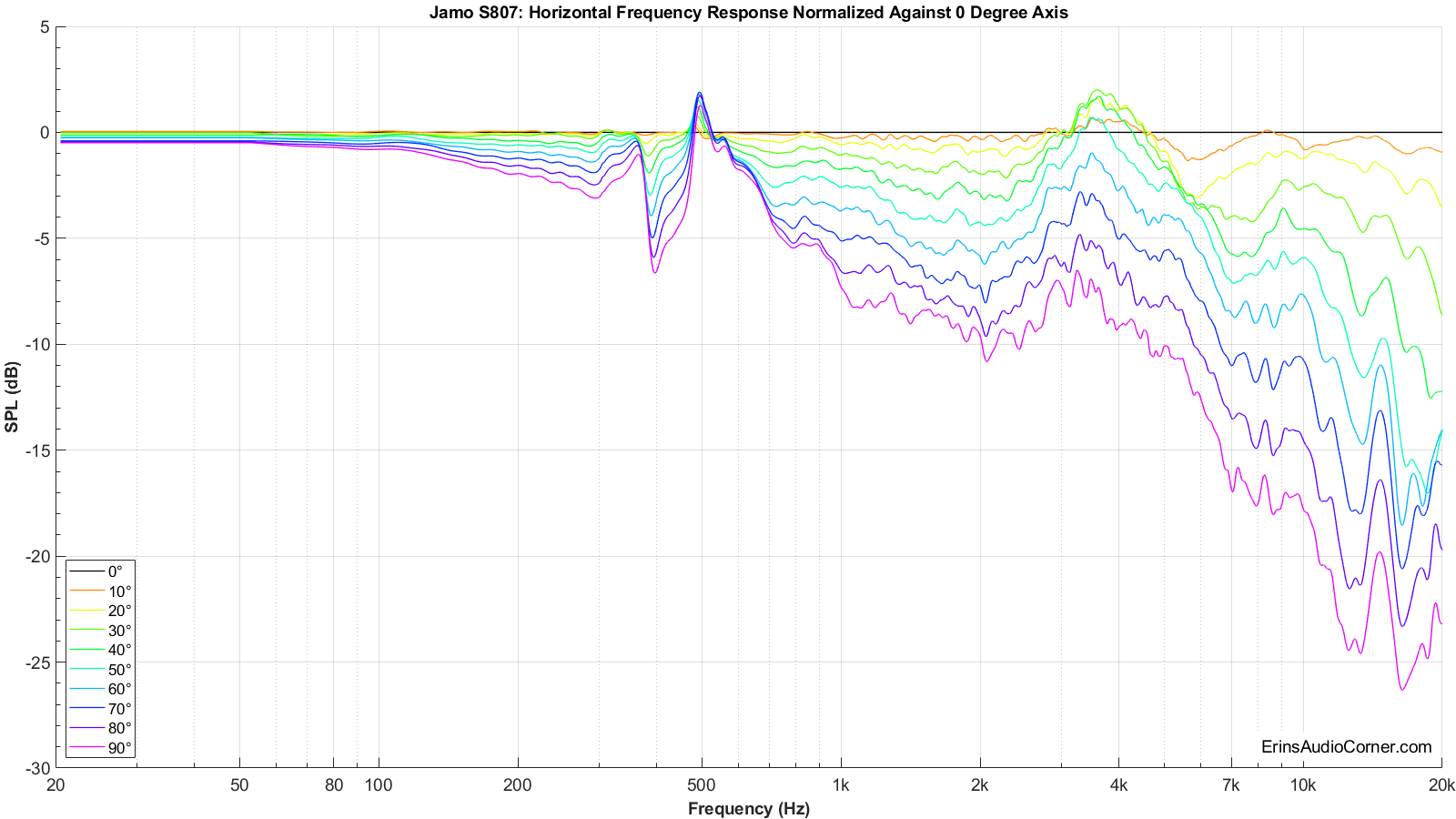
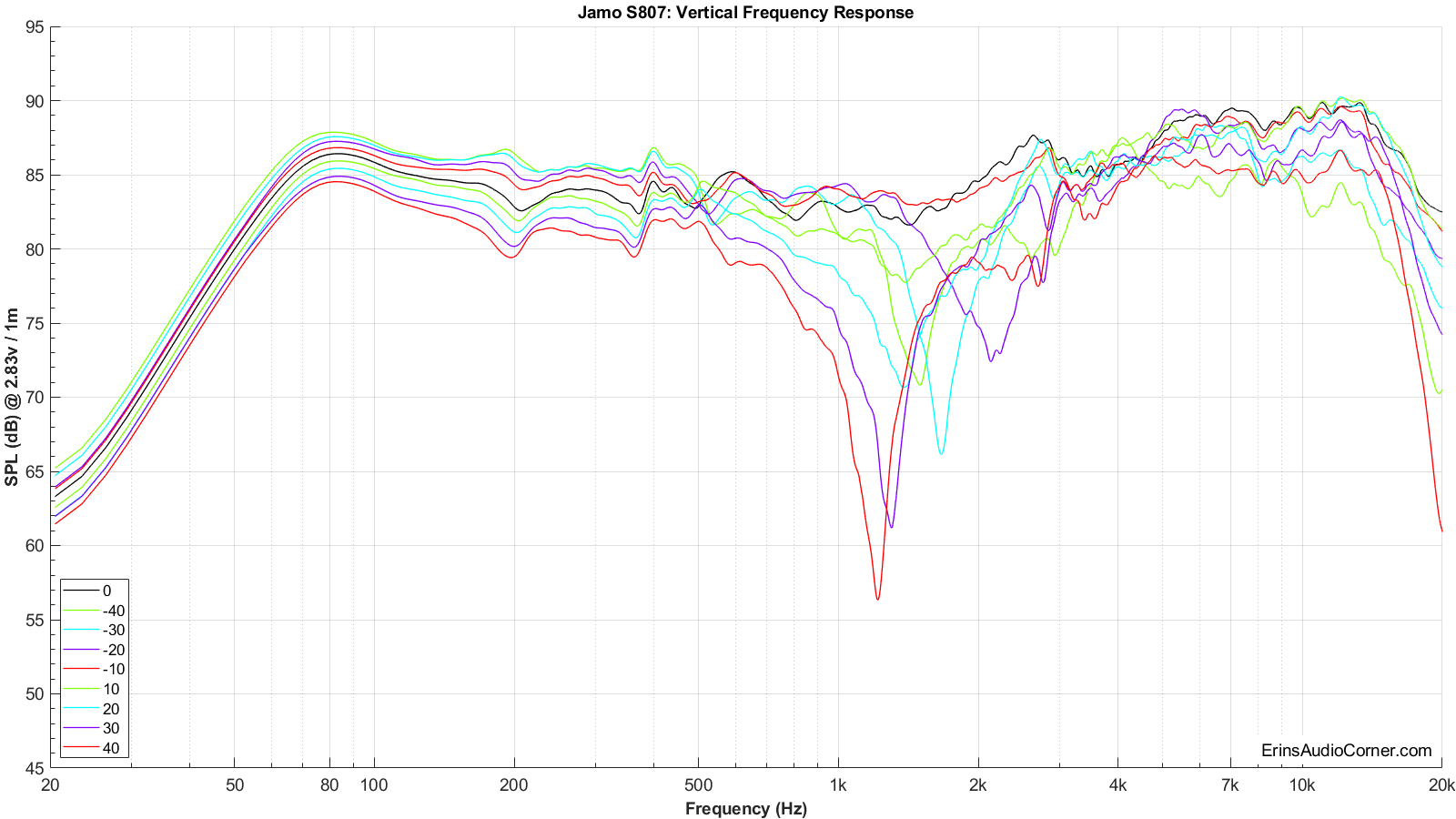
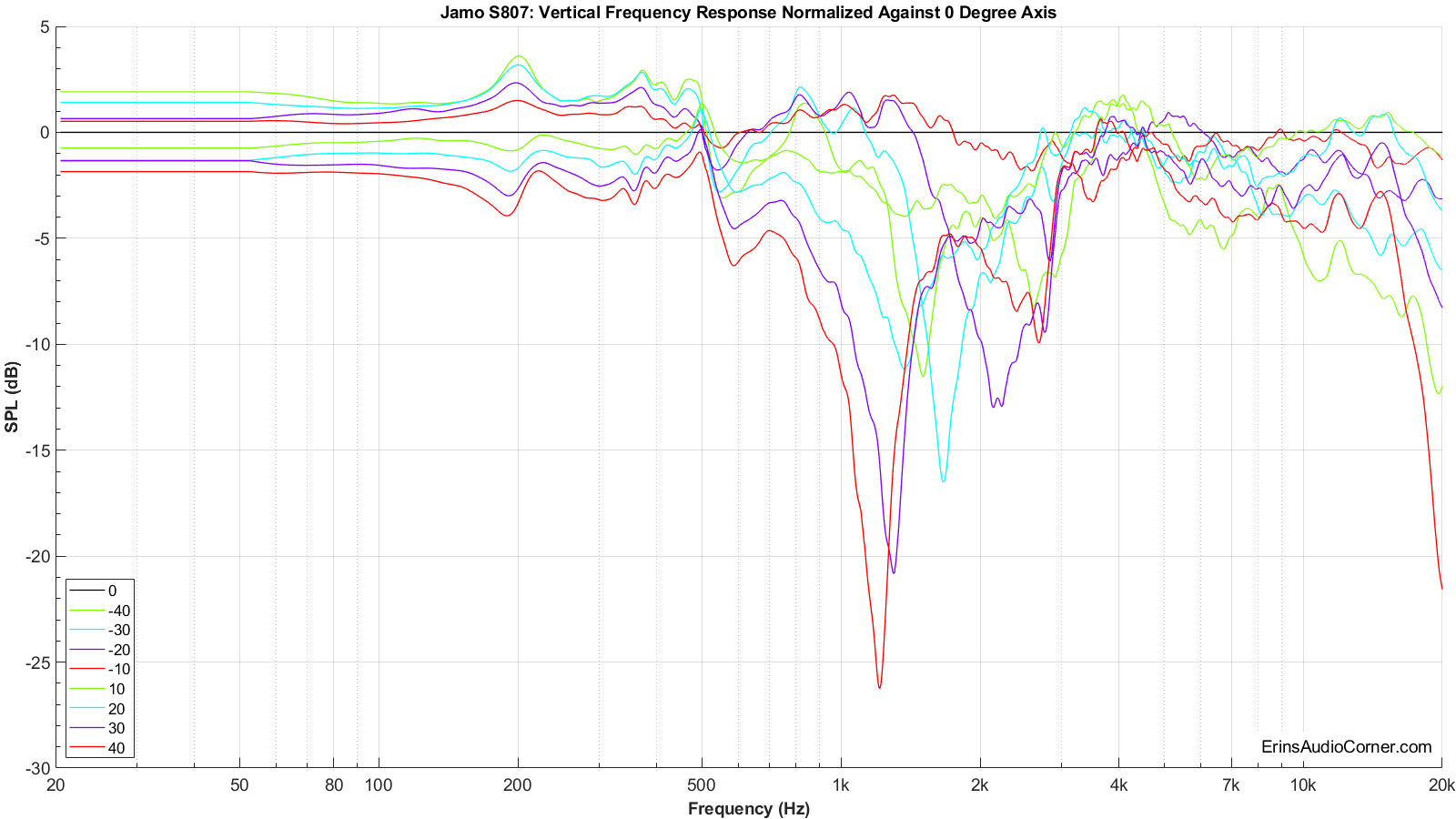
As I said above, the provided frequency response graphs were given with a limited set of data. I measured the response of the speaker’s vertical and horizontal axis in 10-degree steps over 360-degrees. Nearly 70 measurements in total are represented in my data. As you can imagine, providing all those data points in a single FR-type graphic below is a bit overwhelming and confusing for the viewer. A spectrogram is an alternate way to view this full set of data. This takes a 360-degree set of data and “collapses” it down to a rectangular representation of the various angles’ SPL. I have provided two sets of data: one set for horizontal and one for vertical. Each set consists of 3 graphics:
- Full response (20Hz - 20kHz with the angles from 0° to ±180°) with absolute SPL values
- Full, “normalized” response (20Hz - 20kHz with the angles from 0° to ±180°) with SPL values relative to the 0-degree axis
- Normalized, “zoomed” response (200Hz - 20kHz with the angles from 0° to ±90°) with SPL values relative to the 0-degree axis
Normalized plots make it easier to compare how the speaker’s off-axis response behaves relative to the on-axis response curve.

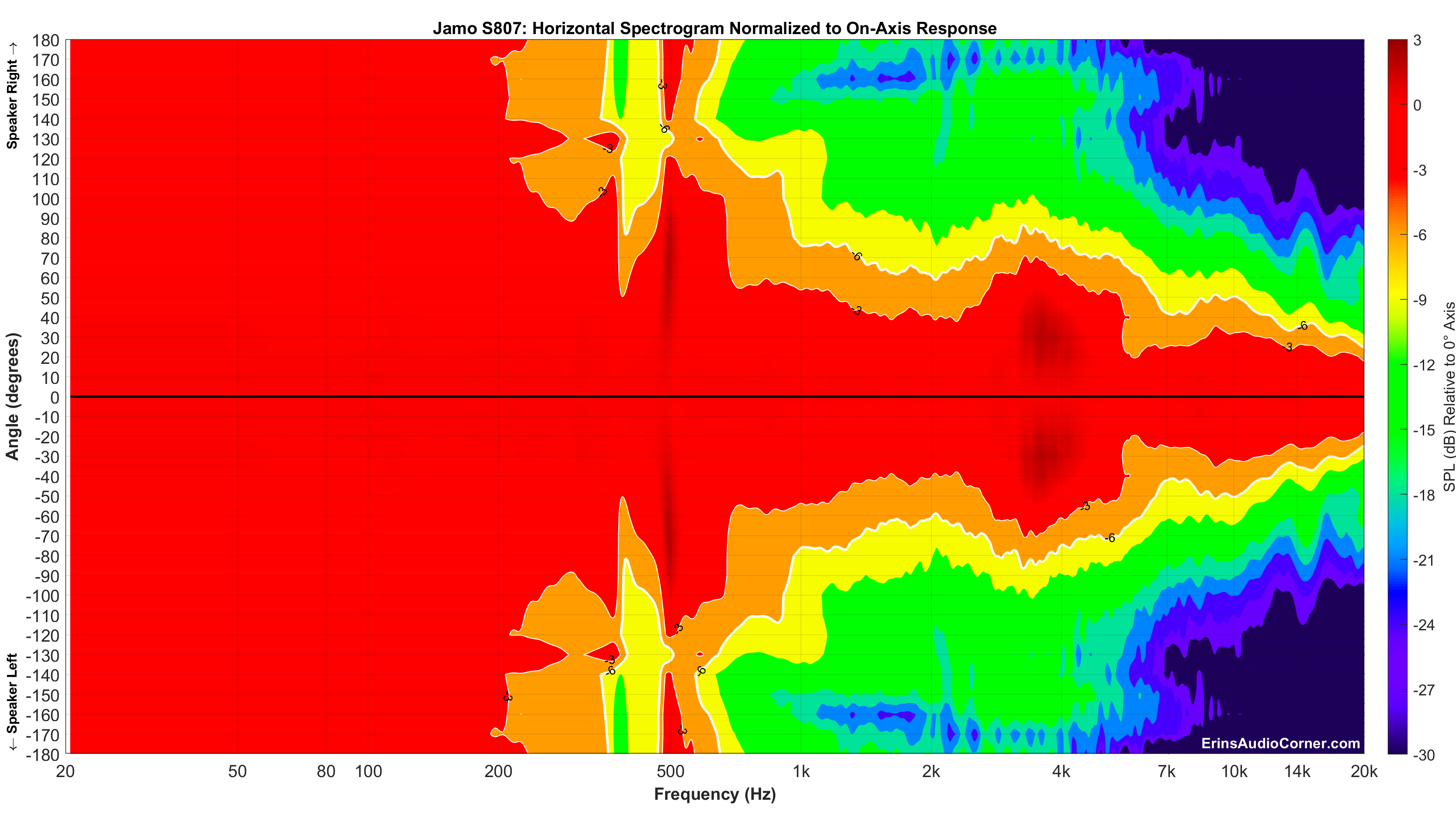
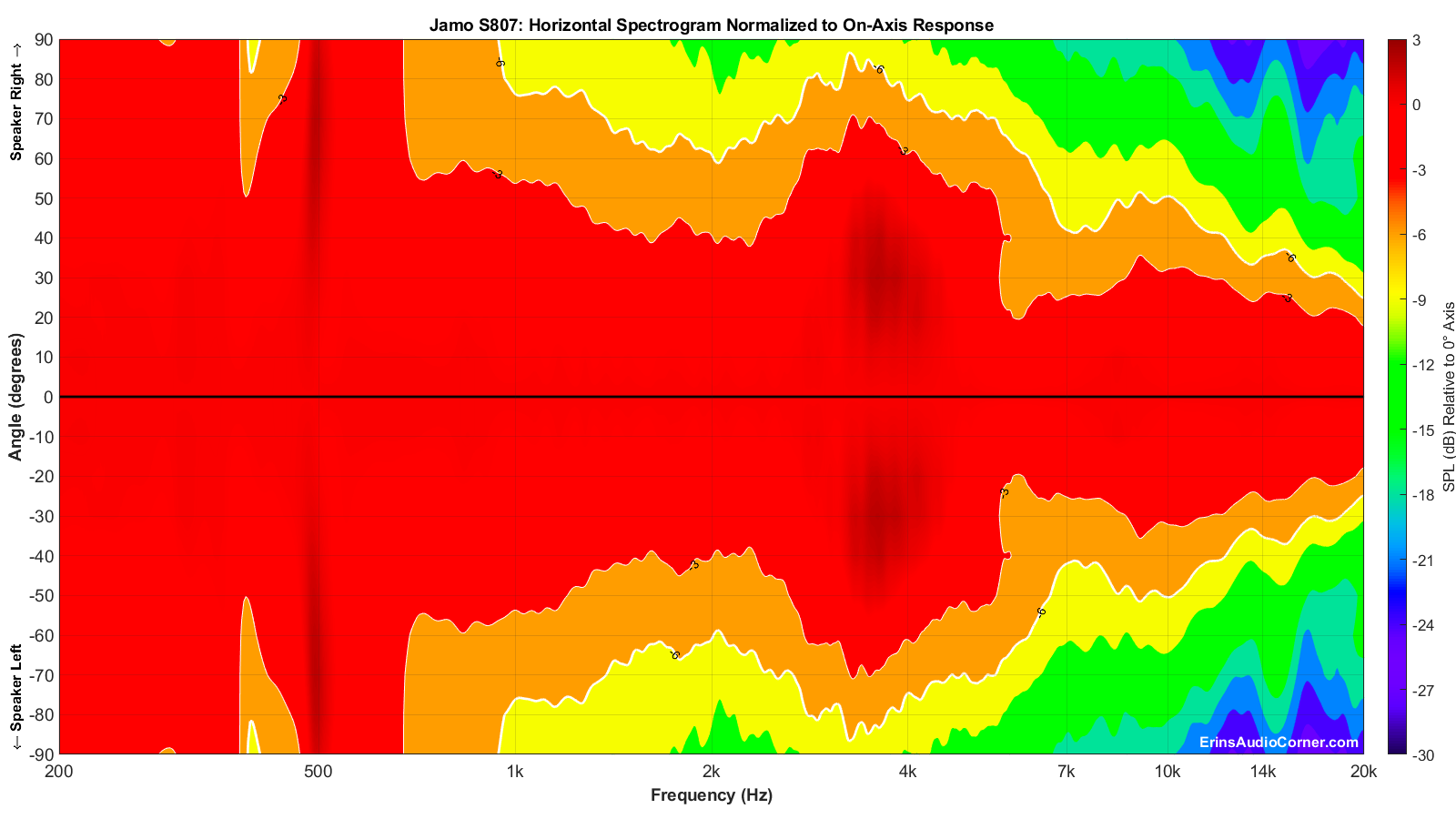
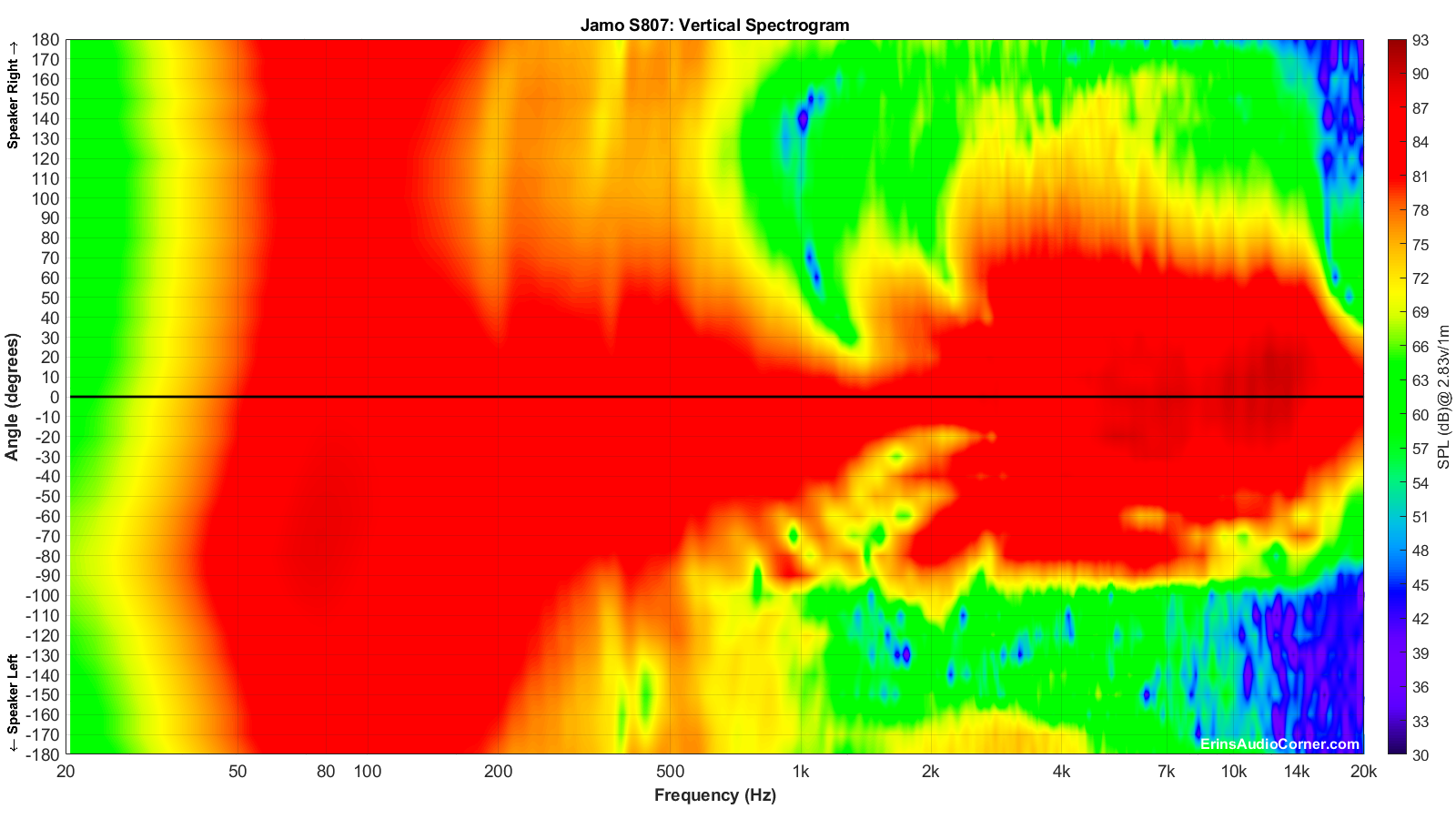
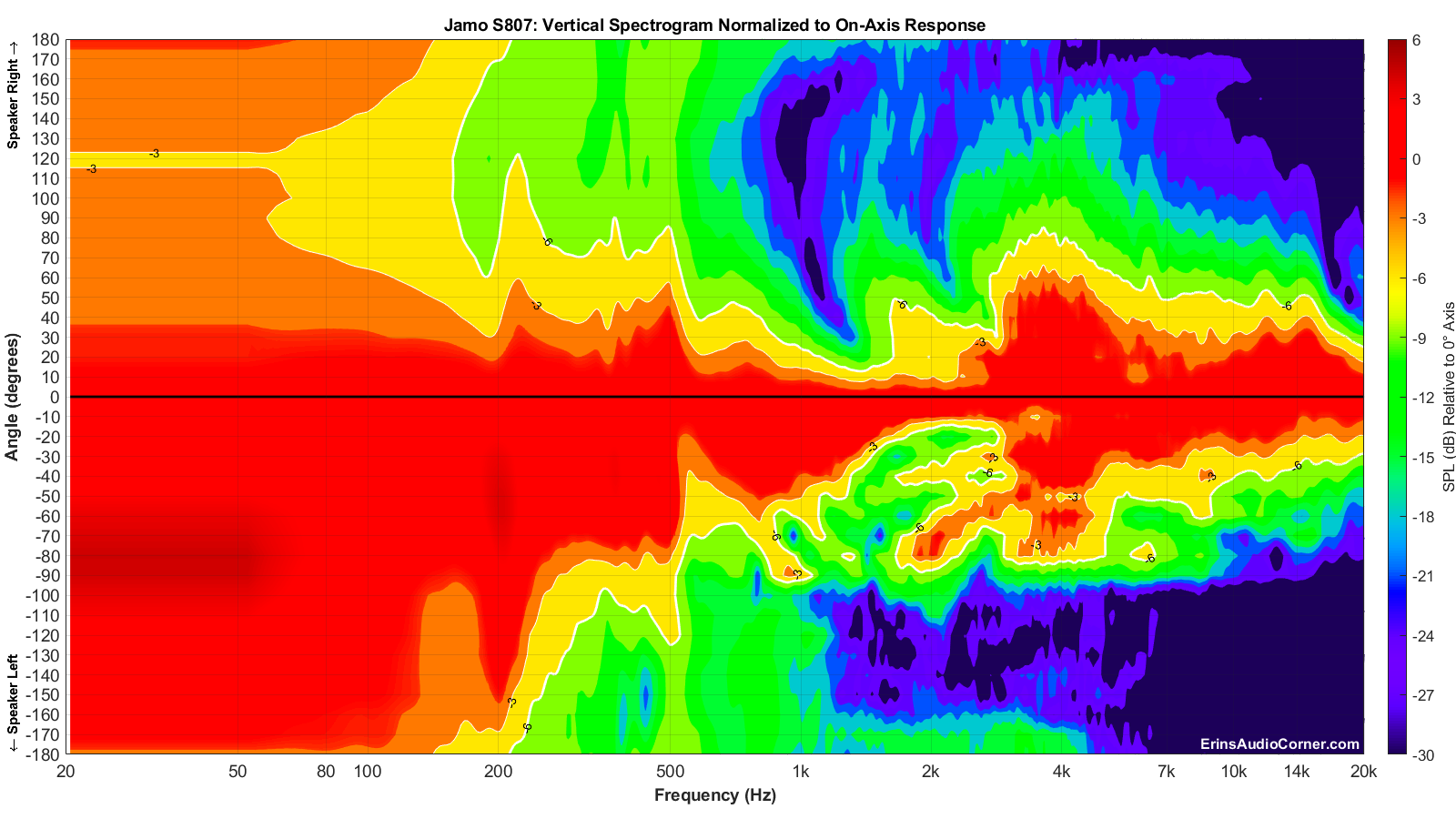
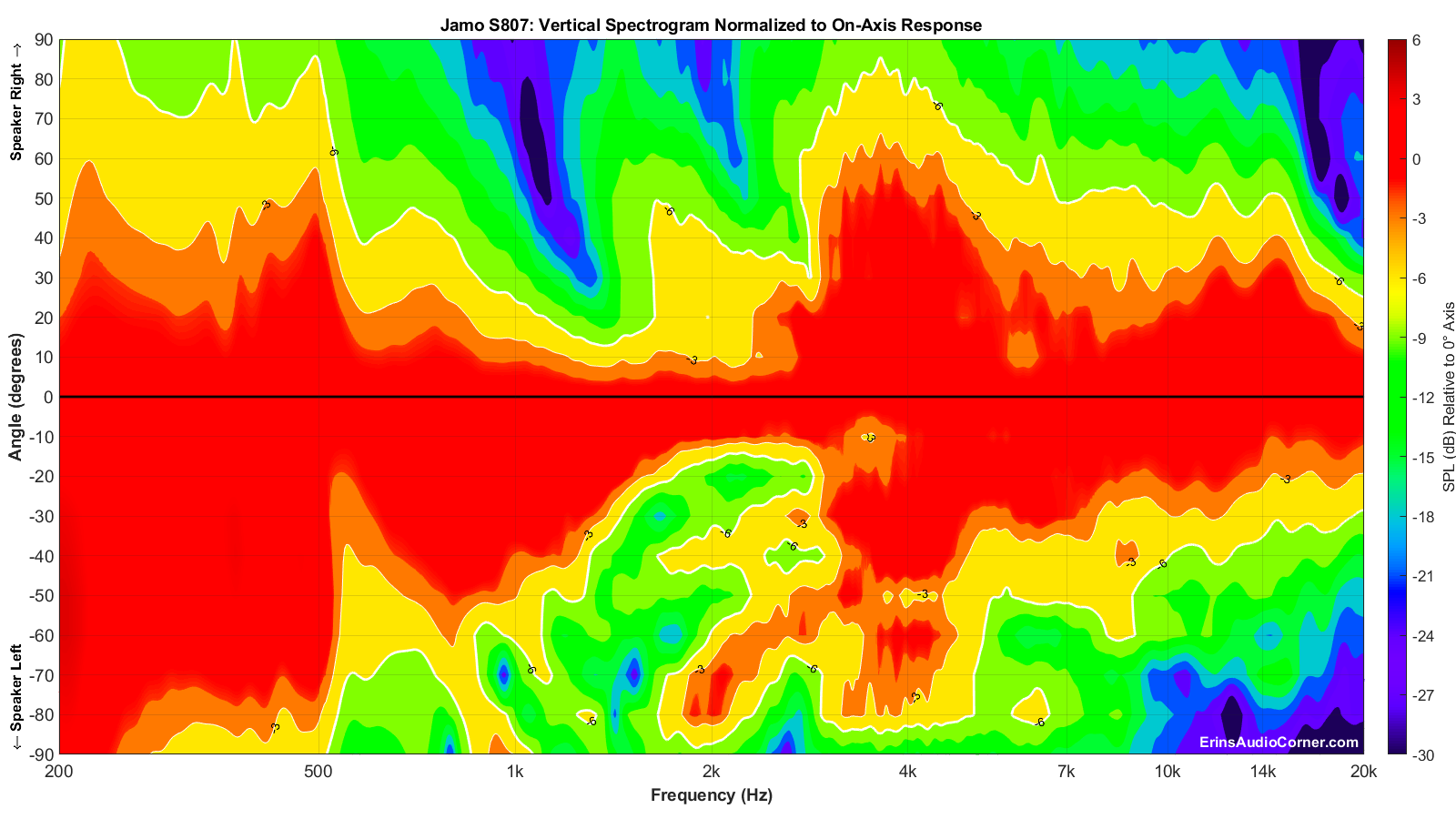
The above spectrograms are the standard way of providing directivity graphics by most reviewers. Some prefer not to normalize the data. Some prefer to normalize the data. Either way, it’s a useful visual to get an idea of the directivity characteristics of a speaker or driver.
However, these “collapsed” representations of the sound field are not very intuitively viewed. At least not to me. So, I came up with a different way to view the speaker’s horizontal and vertical sound field by providing it across a 360° range in a globe plot below. I have provided both an absolute SPL version as well as a normalized version of both the horizontal and vertical sound fields.
Note the legend provided in the top left of each image which helps you understand speaker oreientation provided in my global plots below.
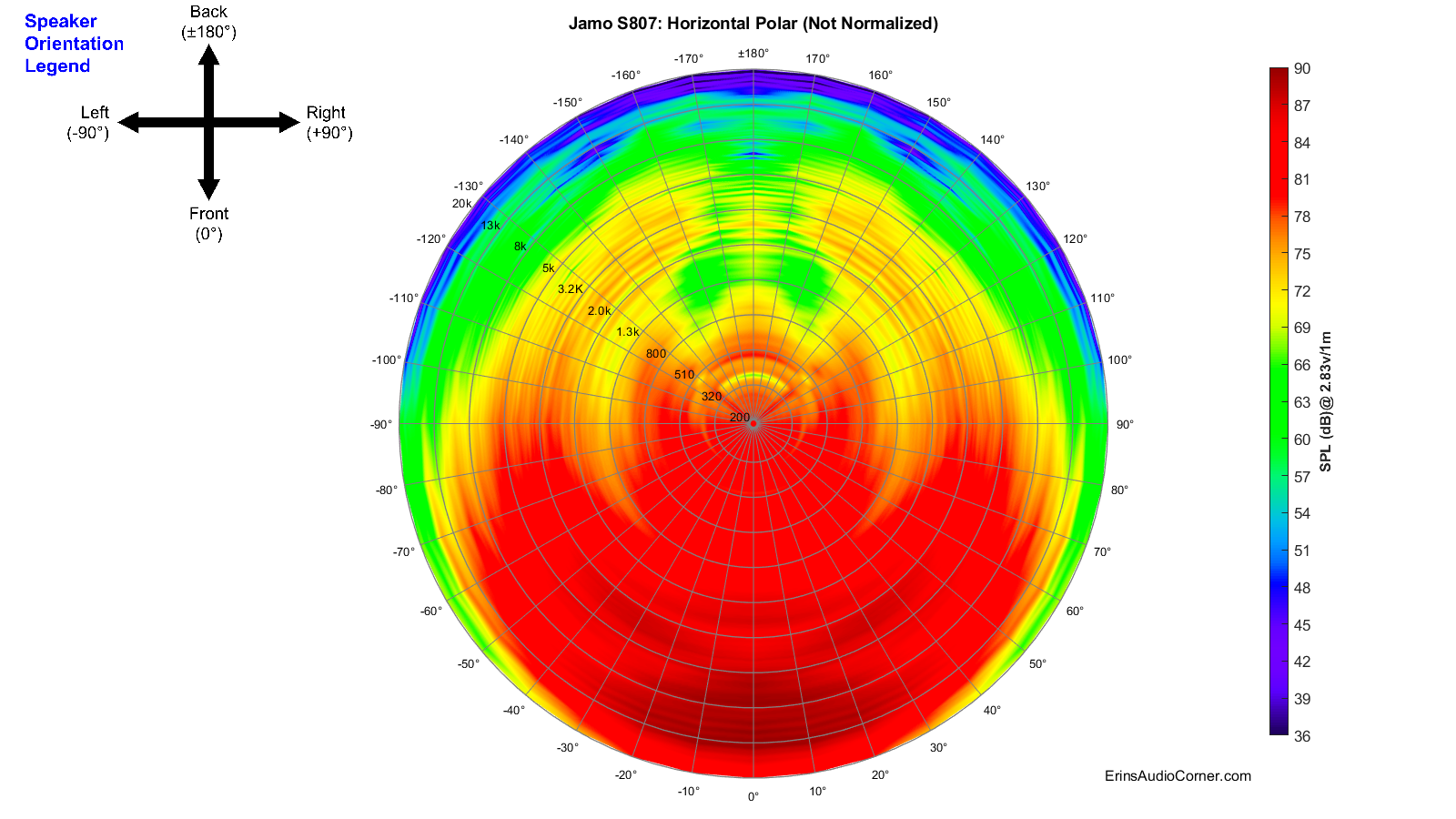
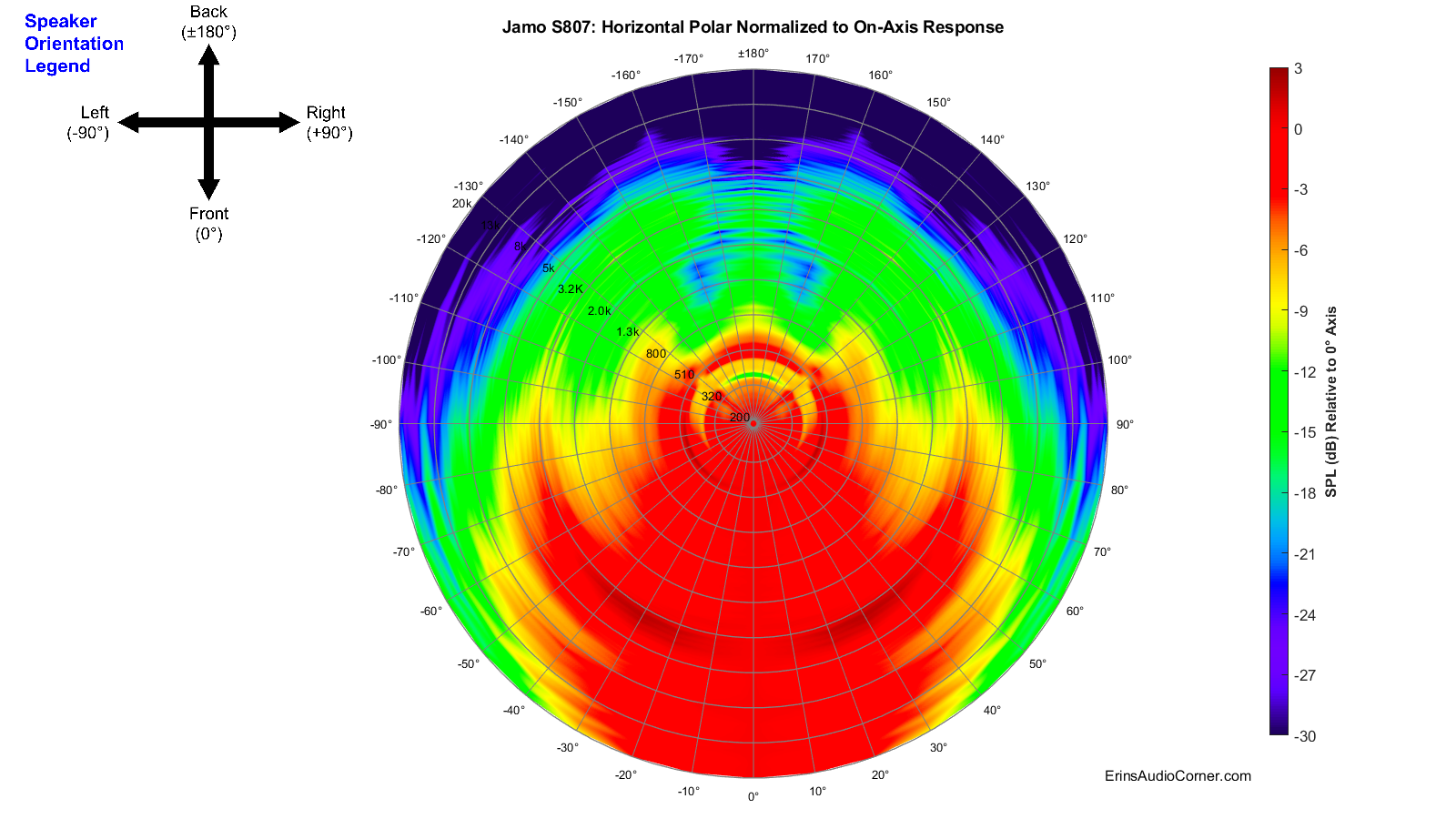

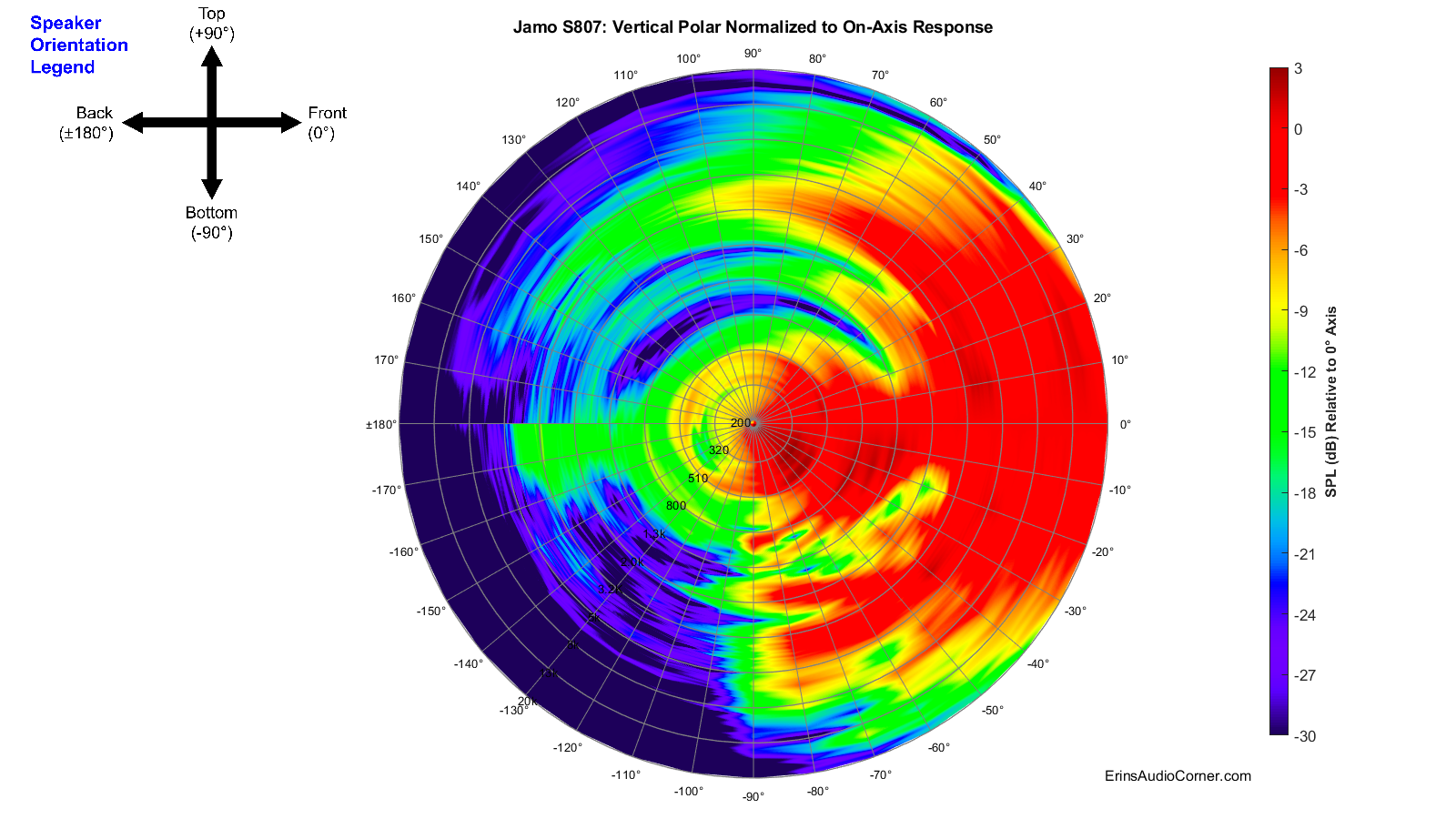
CEA-2034 (aka: Spinorama):
The following set of data is populated via 360-degree, 10° stepped, “spins” from vertical and horizontal planes resulting in 70 unique measurements. Thus, this is sometimes referred to as “Spinorama” data. Audioholics has a great writeup on what these data mean (link here) and there is no sense in me trying to re-invent the wheel so I will reference you to them for further discussion. However, I will explain these curves lightly and provide my own spin on what they mean (pun totally intended). Sausalito Audio also has a good write-up on these curves here. Furthermore, you can find discussion in Dr. Floyd Toole’s book “Sound Reproduction”. Here’s my Amazon affiliate link if you want to purchase it and help me earn about 2% of the price. And, finally, here is a great video of Dr. Toole discussing the use of measurements to quantify in-room performance.
In short, the CEA-2034 graphic below takes all the response measurements (horizontal and vertical) and applies weighting and averaging to sub-sets and can help provide an (accurate) prediction of the response in a typical room. If there is a single set of data to use in your purchase decision, this is probably it.
Alternatively, click this arrow, if you want my quick take on what these curves mean without going to another site.
- On-Axis is simply the on-axis response. This is the 0-degree response curve.
- Listening Window is an average of the 0° to ±30° horizontal and 0° to ±10° vertical response curves and is used to understand what listeners typically hear in a home at the sweet spot, or Main Listening Position (MLP). The reason for this extended window of sound is simply because your room makeup might differ from another’s. This curve is an attempt to quantify a speaker’s performance over a smaller window that is often the norm for listening angle differences in various homes. It is important for this curve to very closely mimic the on-axis response. Deviations of the Listening Window curve relative to the on-axis response curve indicates a compromise in the speaker; often caused by directivity changes (as a speaker transitions from one drive-unit to another a la midwoofer to tweeter, or as a tweeter’s response becomes highly directional).
- Early Reflections is very useful because it helps us determine how the room’s influence will alter (corrupt, most of the time) the direct (on-axis) response. Ideally, the speaker radiates sound uniformly with no aberrations; no resonance, no directivity changes as the speaker transitions from the mid to the tweeter and so on. Because speakers often have these issues, however, what is reflected to us from the walls, ceiling and floor is not the same as what we hear from the on-axis, direct sound. And that’s a problem. Why is that a problem? As stated in Dr. Toole’s book “these are very influential in establishing timbral and spatial qualities”. Large deviations in this relative to the on-axis response also indicate areas where the room is of consequence. Also, it is important to understand the Early Reflections response is made up of rear-firing sounds. A speaker drive-unit is omnidirectional (radiating in all angles evenly) until the half-wavelength equals that of the drive-unit diameter. When the diameter is larger than the wavelength being played, the sound transitions from omnidirectional to directional; also known as “beaming”. Even tweeters beam. For example, a 1-inch dome tweeter will beam at approximately 6750Hz (speed of sound ÷ 2 ÷ diameter). In most speakers you have a single tweeter, firing forward. You can imagine that the high-frequency response in the front of the speaker would therefore be quite different than what is measured behind the speaker. So, being that the Early Reflections curve includes rear-hemisphere measurements you can understand that the high-frequency response would slope downward vs the on-axis response. This is understood and accepted.
- Predicted In-Room Response curve has the benefit of showing directivity mismatches at the crossover as well as resonances easily by comparing them to the overlaid Target curve (further down).
- Directivity Index (DI) curves are the difference in the Listening Window and the respective Early Reflections or Sound Power curves. My understanding, currently, is the Sound Power and Sound Power DI aren’t quite as useful for typical homes. However, there is emphasis placed on the Early Reflections DI curve. The right Y-Axis provides a value associated with the DI curves. The higher the number, the more directional the speaker. For example: a “0” DI curve - a curve which is completely flat - would be a speaker that is purely omnidirectional; radiating uniformly in all angles vertically and horizontally. A speaker that increases over frequency means that it is radiating in a tighter window as you increase in frequency. This is typical because, as I discussed above, even tweeters beam… and most speakers have a single tweeter facing the front and therefore, the speaker becomes directional at whatever the tweeter’s beaming frequency is. There isn’t necessarily a one-size-fits-all DI curve value. Though, it seems people (myself included) prefer a speaker with a wider soundstage which is found in lower directivity speakers (because more sound is bouncing off the side walls; which confuses the use of side-wall absorption but that’s for a later debate). However, what is important is that the curve, however tall you may prefer it to be, is smooth; almost linear. Dips and peaks mean that something, not good, is going on. But a linear curve indicates excellent transition through crossover regions, no resonance, etc. Since speakers are not perfect, though, linear DI curves are not the norm. Speakers become directional as they increase in frequency, around strong resonances, and as the sound transitions at the crossover from one drive-unit to another and you wind up with areas with peaks and/or dips whether they’re spread through a wide frequency range (low-Q) or very sharp/drastic (high-Q). But when you’re looking at the Early Reflections DI curve, look for this: smooth.
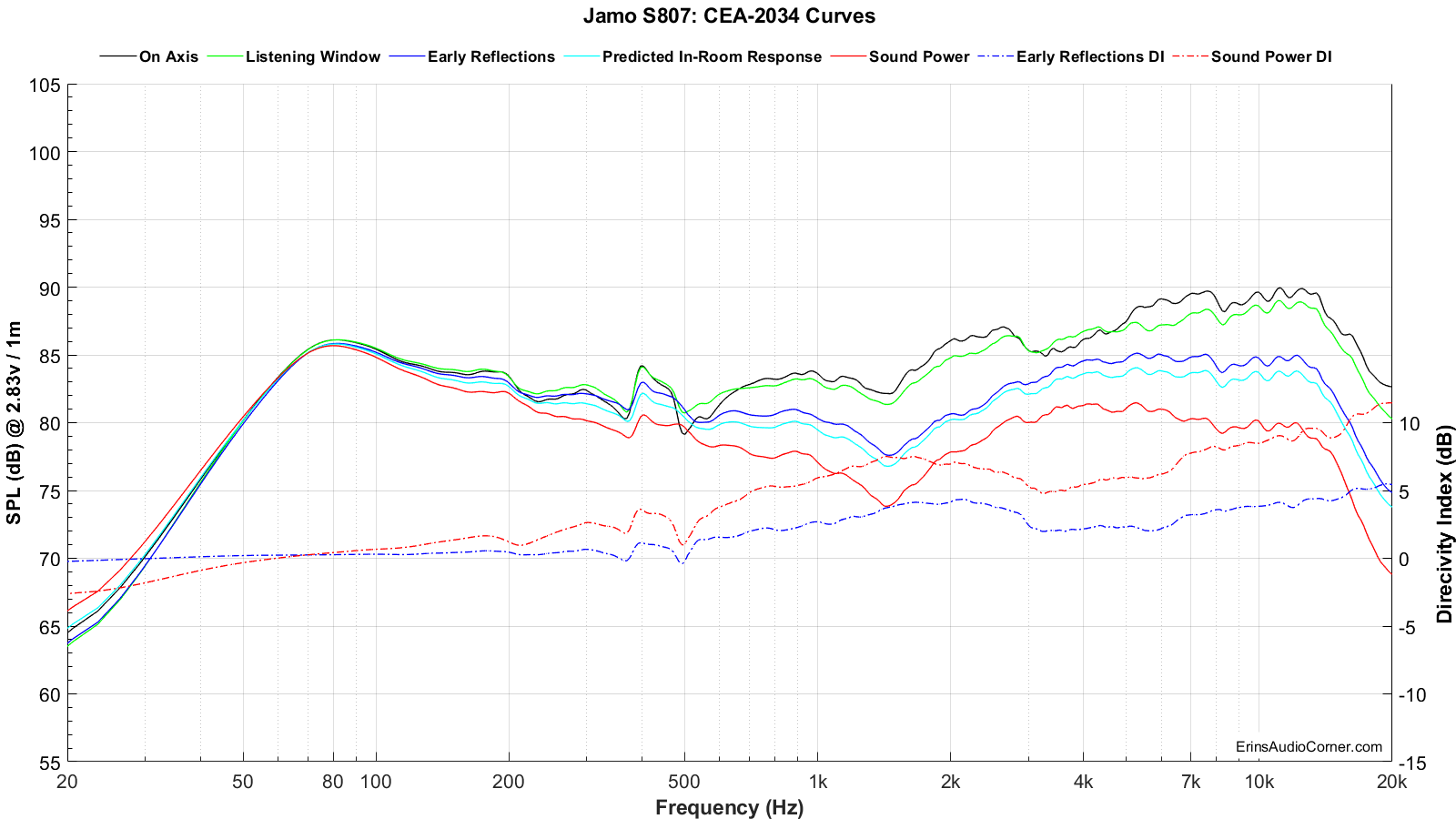
What we can learn from this data is that this speaker has serious directivity problems. You can see it in the above spectrogram and globe plots as well as in all the measurements in the above graphic. There is a strong resonance that shows up at about 400Hz as evidenced by the peak. There is a directivity change at this point, easily seen by viewing the Early Reflections DI curve (dashed blue). The directivity increases in the mid-to-upper midrange, starting at a DI value of ~0dB at 500Hz and ending at ~5dB at 1.5kHz. I found this to be attributed to the (2) 5-inch woofers’ crossover which will be shown in the Miscellaneous section below. These woofers appear to roll off quite low for a reason I don’t understand. From about 2kHz to 3kHz the directivity decreases; this is due to the tweeter’s omnidirectional radiation and then rises from 2.5dB at 3kHz to ~5.5dB at 20kHz. This change in directivity through multiple reasons means that the soundstage width (for one) will not be stable. As the directivity increases sharply whatever is radiated in the 0° axis is not radiated at the sides and up in the Early Reflections window (angles defined above). You wind up with a soundstage that does weird stuff like throwing a wide image at certain frequencies while being narrow at others.
Below is a breakout of the typical room’s Early Reflections contributors (floor bounce, ceiling, rear wall, front wall and side wall reflections). From this you can determine how much absorption you need and where to place it to help remedy strong dips from the reflection(s). The deep null in the Ceiling Bounce curve (dashed magenta) at 1.3kHz is likely due to the off-axis lobing effect between the midwoofers and the tweeter; you can see this trend show up in all the vertical spectrograms and notably in the vertical globe plots.
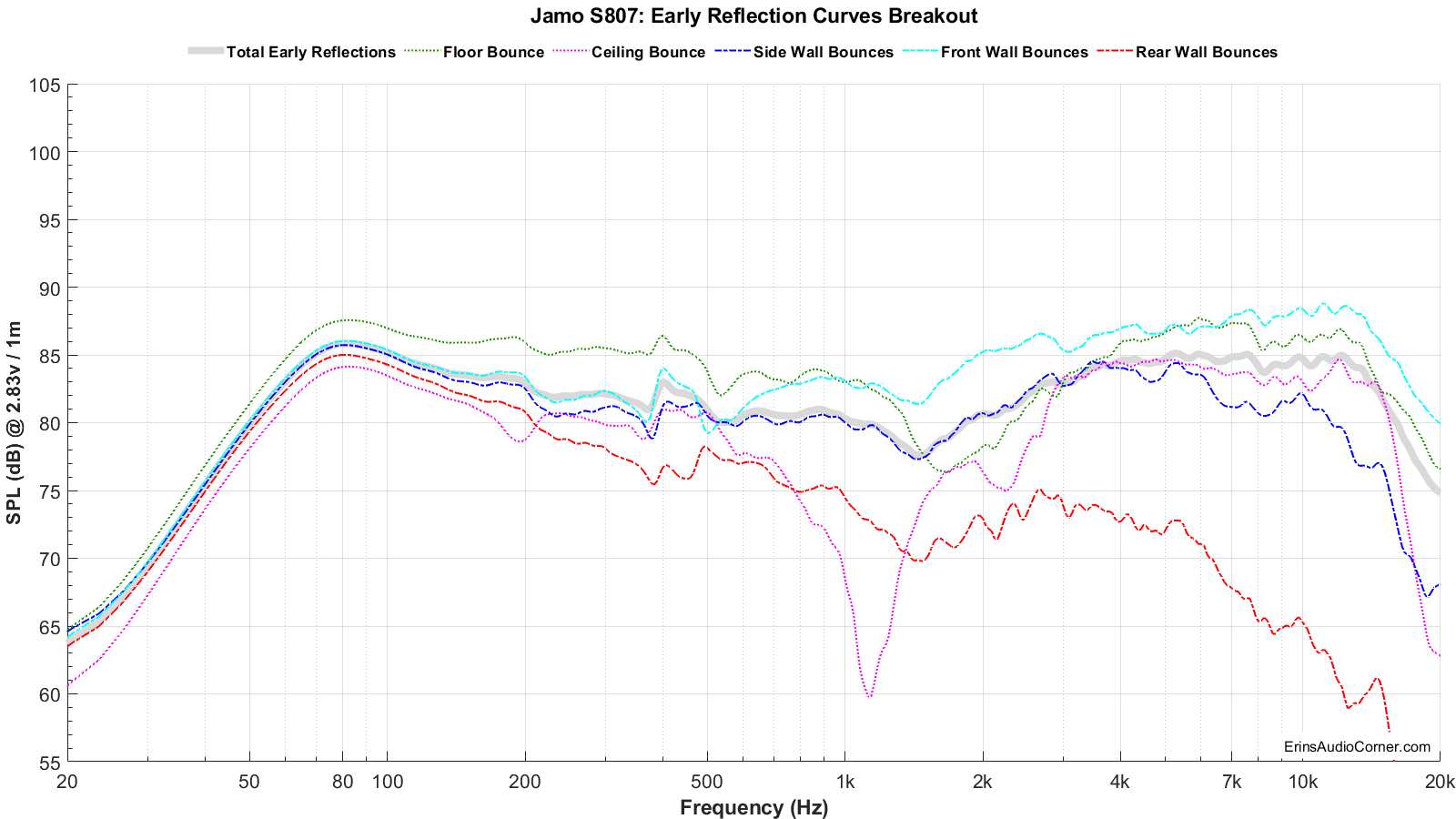
And below is the Predicted In-Room response compared to a general Target curve equaling -1dB/octave.
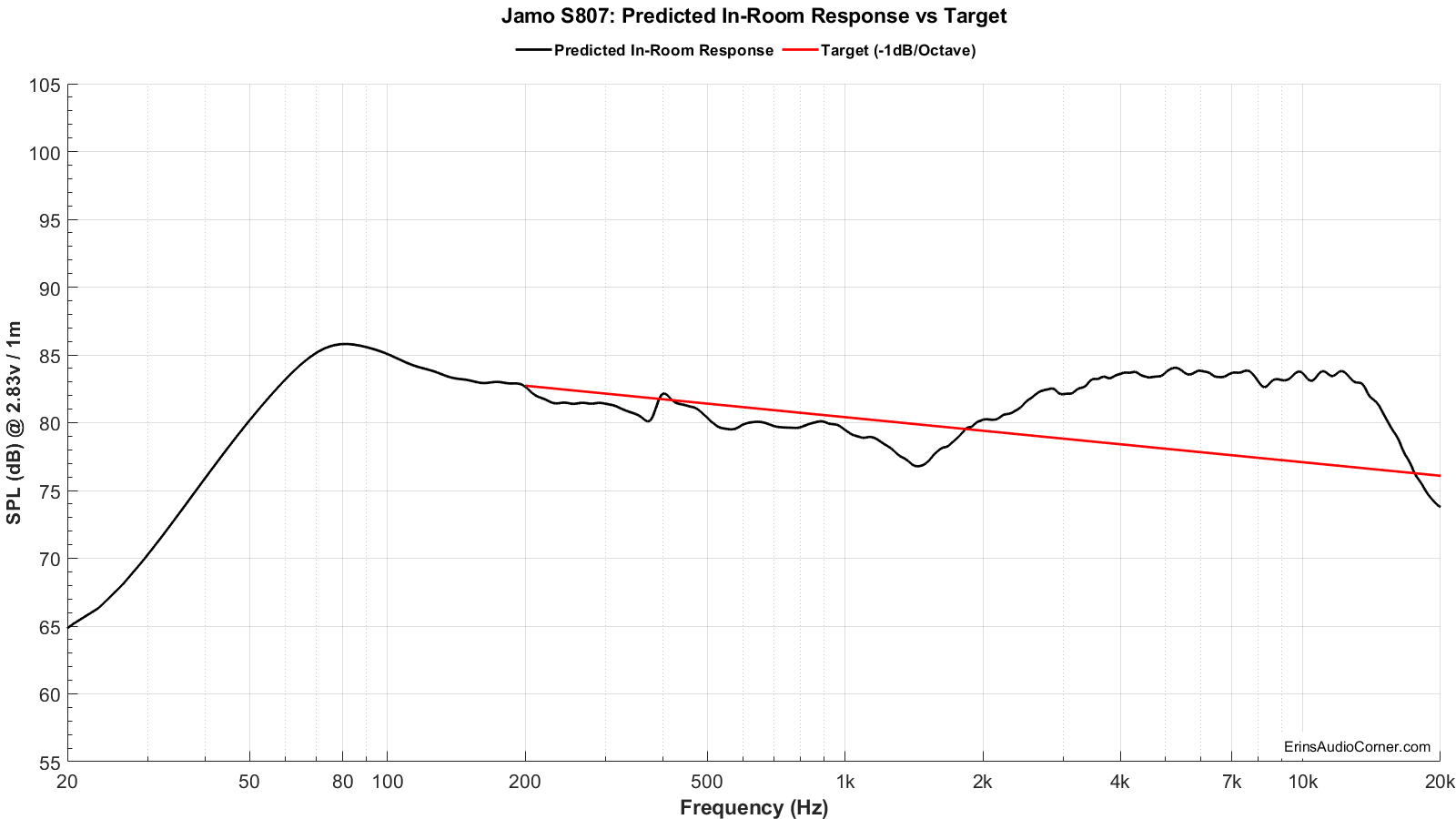
You may ask just how useful the above prediction is. Well, I’d be remiss for not delving in to that a little bit here. Please see my Analysis section below for discussion on this. :)
Total Harmonic Distortion (THD) and Compression:
Distortion and Compression measurements were completed in the nearfield (approximately 0.3 meters). However, SPL provided is relative to 1 meter distance.
Harmonic Distortion and Compression: What does this data mean? (click me for info)
Harmonic Distortion and Compression are provided at varying levels to get an idea of what happens as the voltage into the speaker is increased and overall output volume increases. The “mean spl” values associated with each voltage provided in the legend is based on a calculation of expected volume assuming linear volume at the 300-3kHz region. Meaning, if a speaker is ideal and you tell your stereo to increase by 6dB by turning the volume knob +6dB, the output will increase by 6dB. In the real-world, however, a speaker is a mechanical device and there are compression effects that can limit the output volume and, therefore, you could possibly only get an actual increase in volume of 5dB. A good speaker will have little compression (< 1dB), where poorer speakers may suffer greater compression (> 2dB). Generally speaking, higher sensitivity speakers (like pro-audio speakers with 100dBSPL @ 2.83v/1m spec) suffer relatively no compression while lower sensitivity speakers (low 80’s dBSPL @ 2.83v/1m) suffer more compression. When a crossover is used the compression near the speaker’s Fs is attenuated and overall the compression effects are mitigated. With that in mind, what you see below is first the Total Harmonic Distortion at varying output levels.
What you see below is first the Total Harmonic Distortion at varying output levels. At 2.83vRMS the mean SPL is about 85dB at 1 meter (over 300-3kHz). Distortion at this output is under 0.50% above 200Hz and hits the 3% mark at about 40Hz. As you’d expect, the distortion increases as volume increases. Namely, near the speaker’s roll off point. Those numbers are pretty good on their own.
However, based on a poll I conducted, most people’s in-room listening distance is between 3 to 4 meters from their speakers at a volume of about 85dB to 90dB. Few people realize just how loud 90dB is. I’ve often found people tend to overestimate their listening levels by a fair bit. But, for the sake of determining how these speakers perform at the higher end of music listening, let’s assume the following: 1) you are in your room and about 4 meters (~ 13 feet) from the speakers and 2) you listen to these speakers at about 90dB at the listening position. The pair of speakers causes a 3dB increase, the room typically adds 6dB, but the change in distance from 1 meter to 4 meters results in a 12dB drop. This equals a total of +3dB from single speaker anechoic 1 meter response to in-room speaker pair at 4 meters. Therefore, in this scenario, you will need to look at the 93dB (7.62vRMS) measurements for THD and Compression.
Using the 93dB measurement tells you the measured low-frequency distortion at about 80Hz is near 3% THD and 6% at 40Hz. Will you hear that? Pure distortion is more subjective and depends not just on the listener but also no the program material. What is of more concern to me is the THD rise above 5kHz where it increases above 2% THD.
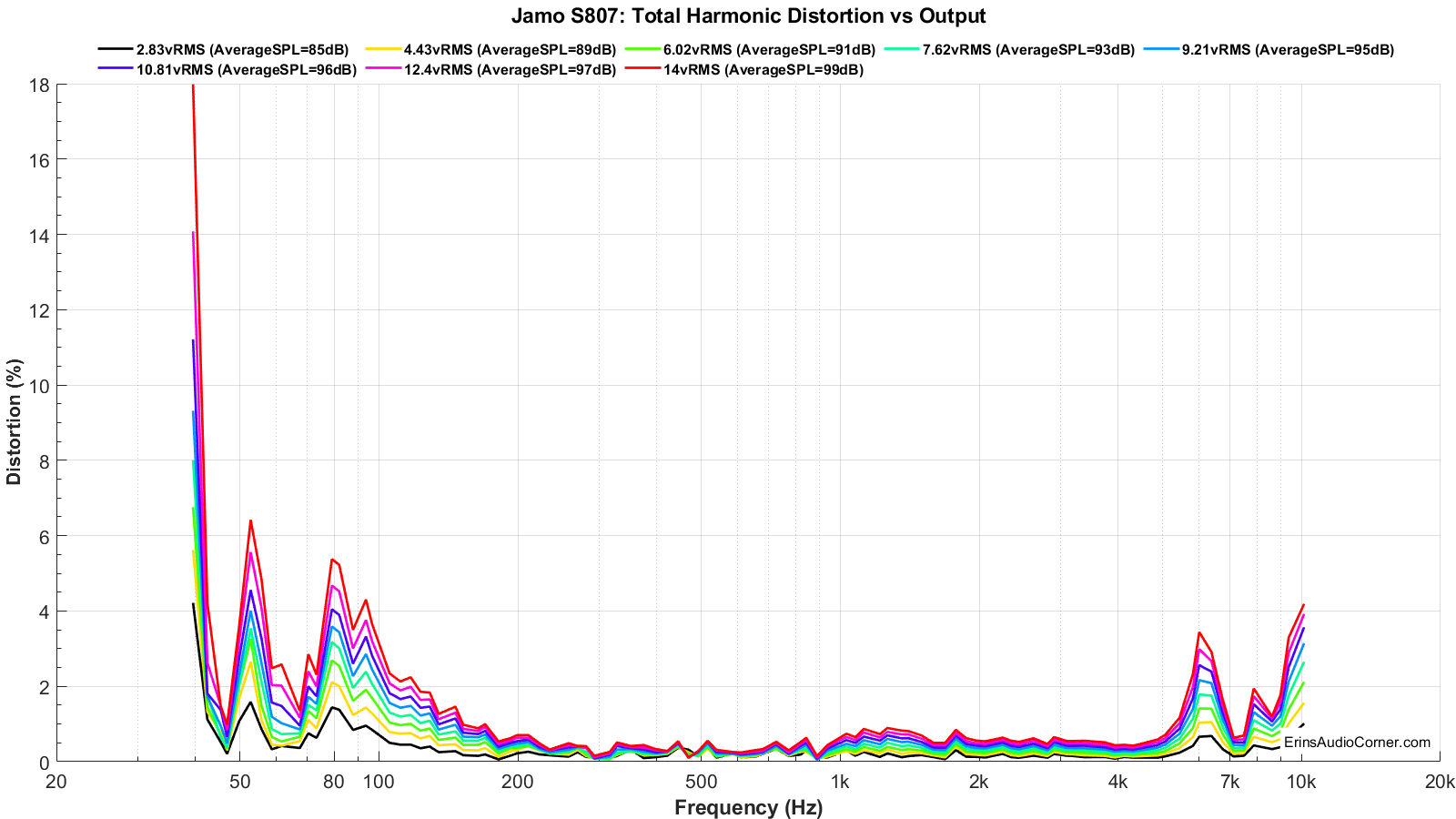
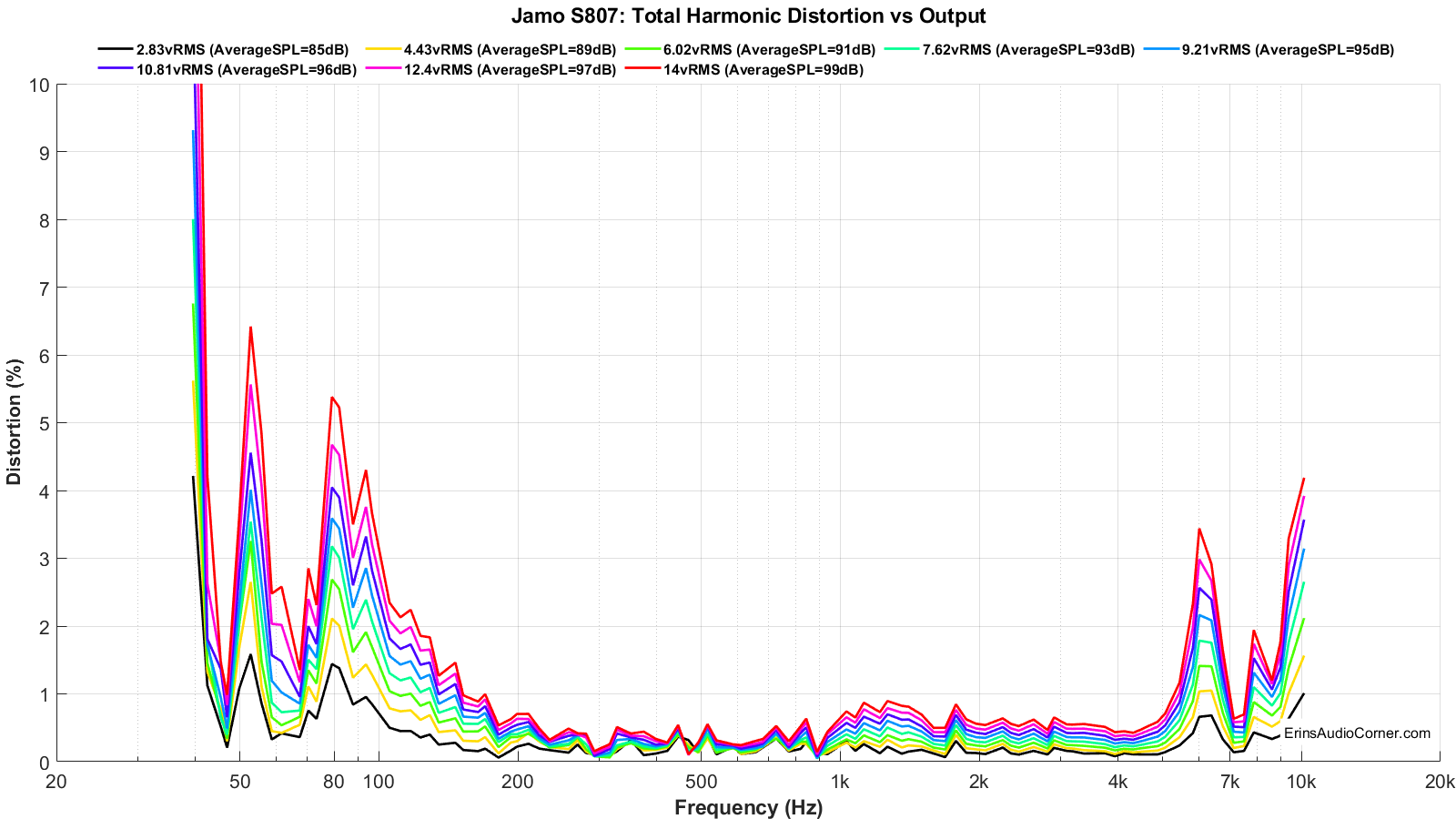
I gave these speakers some significant volume and I heard a lot of distortion, but I think this was due more to compression than the simple tone distortion. I discuss this below…
The compression effects shown in the image below are a visual way of seeing just what happens as the volume is increased. This one is straight-forward. Take the legend’s SPL value and add or subtract the data from the graphic. This tells you if you’re losing or gaining output (yes, you can gain output from compression; as un-intuitive as that seems). Mostly, the compression results in a loss due to temperature increase in the voice coil of the drive unit. Let’s look at a specific example. Take the 90dB at 4 meters target listening volume provided above. Again, you need 93dB’s (7.62vRMS) data. At that volume, the highest amount of compression measured is about 2dB at 40Hz and about 0.50dB at 50Hz, decreasing until about 200Hz. At some points the speaker suffered >3dB compression at 40Hz with 14vRMS. Overall, the compression results for this speaker were bad. At typical listening volume you lose 2dB. And it is audibly present as a very grainy and “limited” sound; there are no dynamics at this output and that’s exactly what I heard in my listening tests.
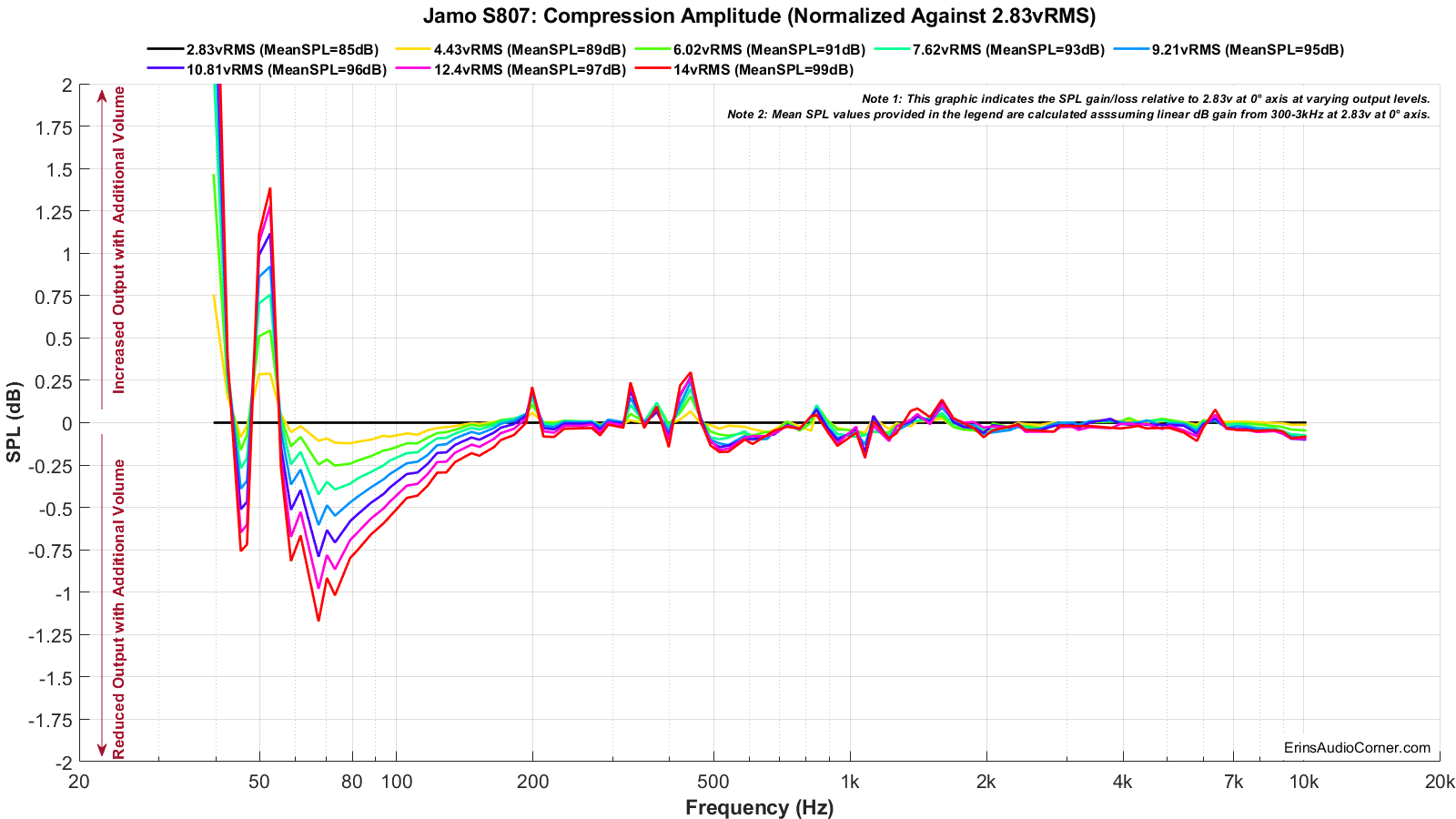
Extra Measurements:
These are just some extra sets of measurements I completed. Some, I didn’t process through my MATLAB scripts so they’re kind of raw. But I know some would like to see them so here you go.
On-Axis Response comparison between Speaker A and Speaker B.
This result shows the difference between the two speakers I received as a pair.
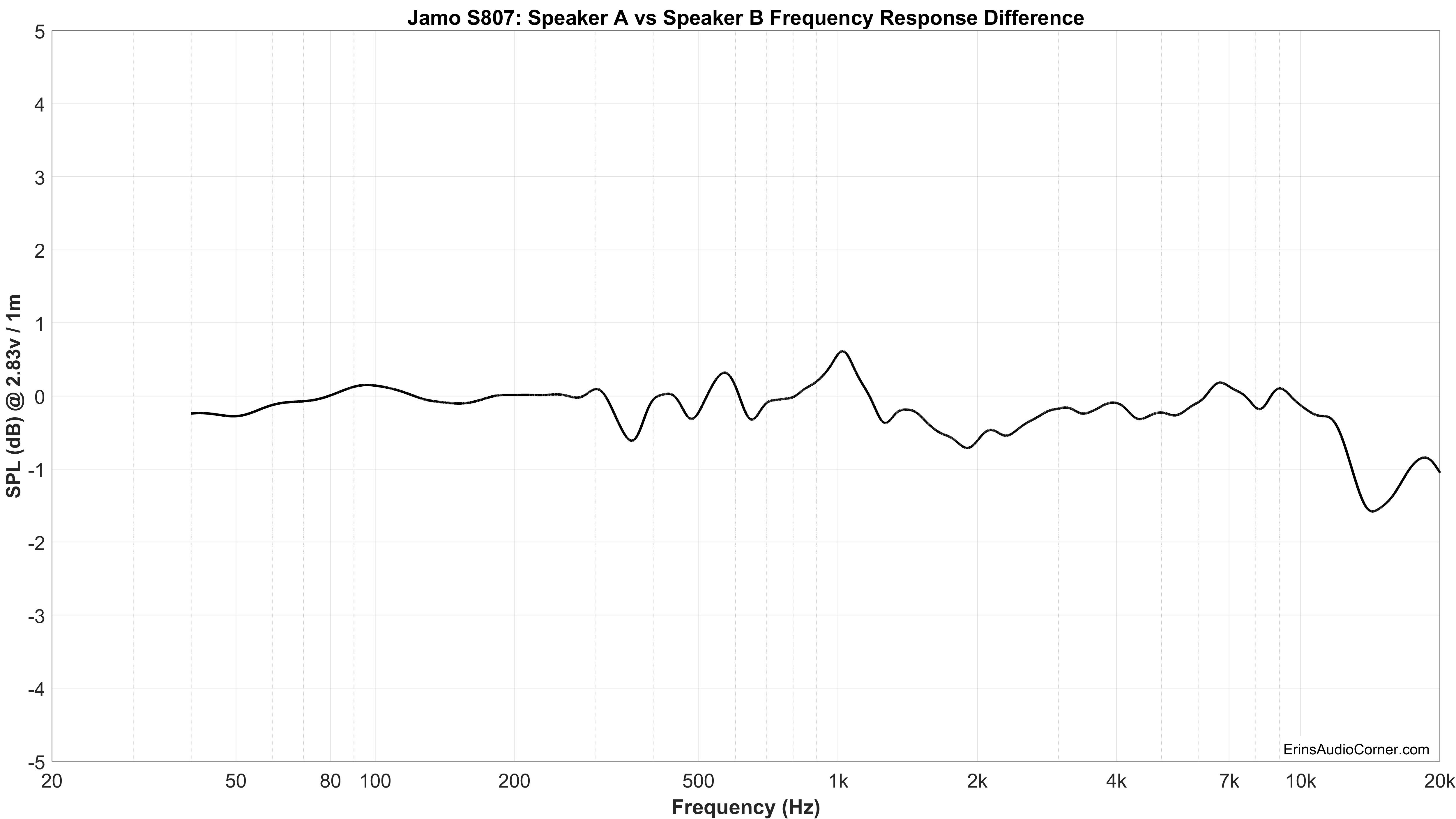
Grille on vs Grille off at 0° and 45°.
The grille on case results in an increase in comb filtering (higher amplitude peaks/dips). Leave the grille off.
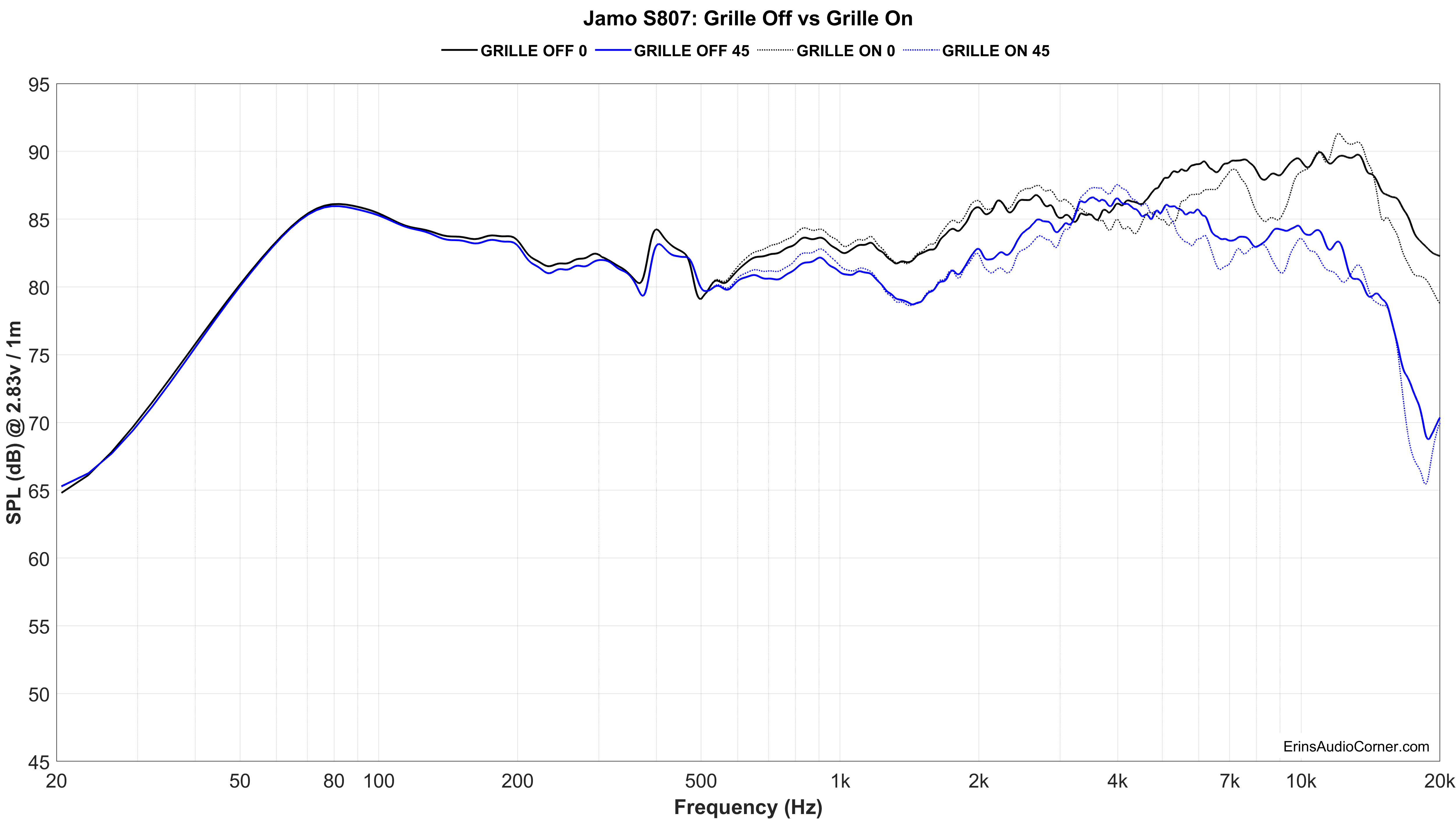
Accelerometer Cabinet Resonance Test.
I used an accelerometer. I attached the accelerometer to the side (top, middle, bottom), back and front of the cabinet and fed a 2.83vRMS signal through the speaker.
Picture of how the accelerometer was affixed to the side, middle.
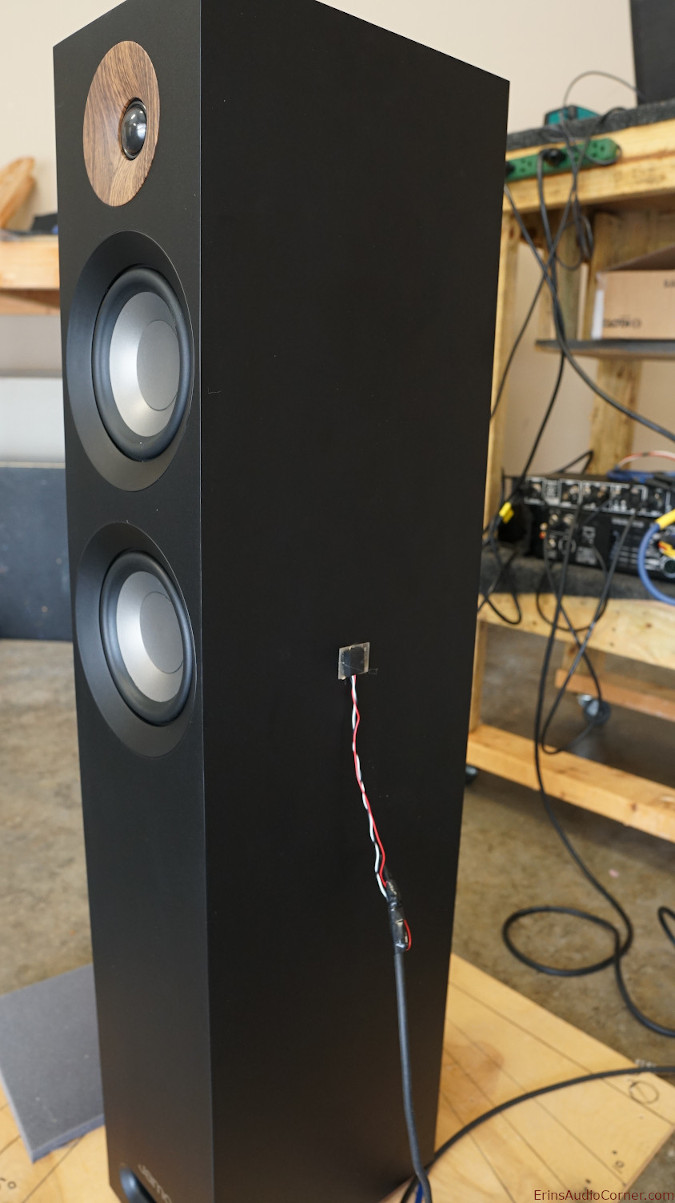
I have overlaid all these results against the on-axis response as well. Note, however, the accelerometer is NOT calibrated for level and therefore is only intended to show relative changes. What you look for in this data is large peaks that would indicate a resonance. It is interesting that there is a peak at ~400Hz which also lines up with the resonance apparent in the frequency response as well as the resonance in the impedance shown earlier.
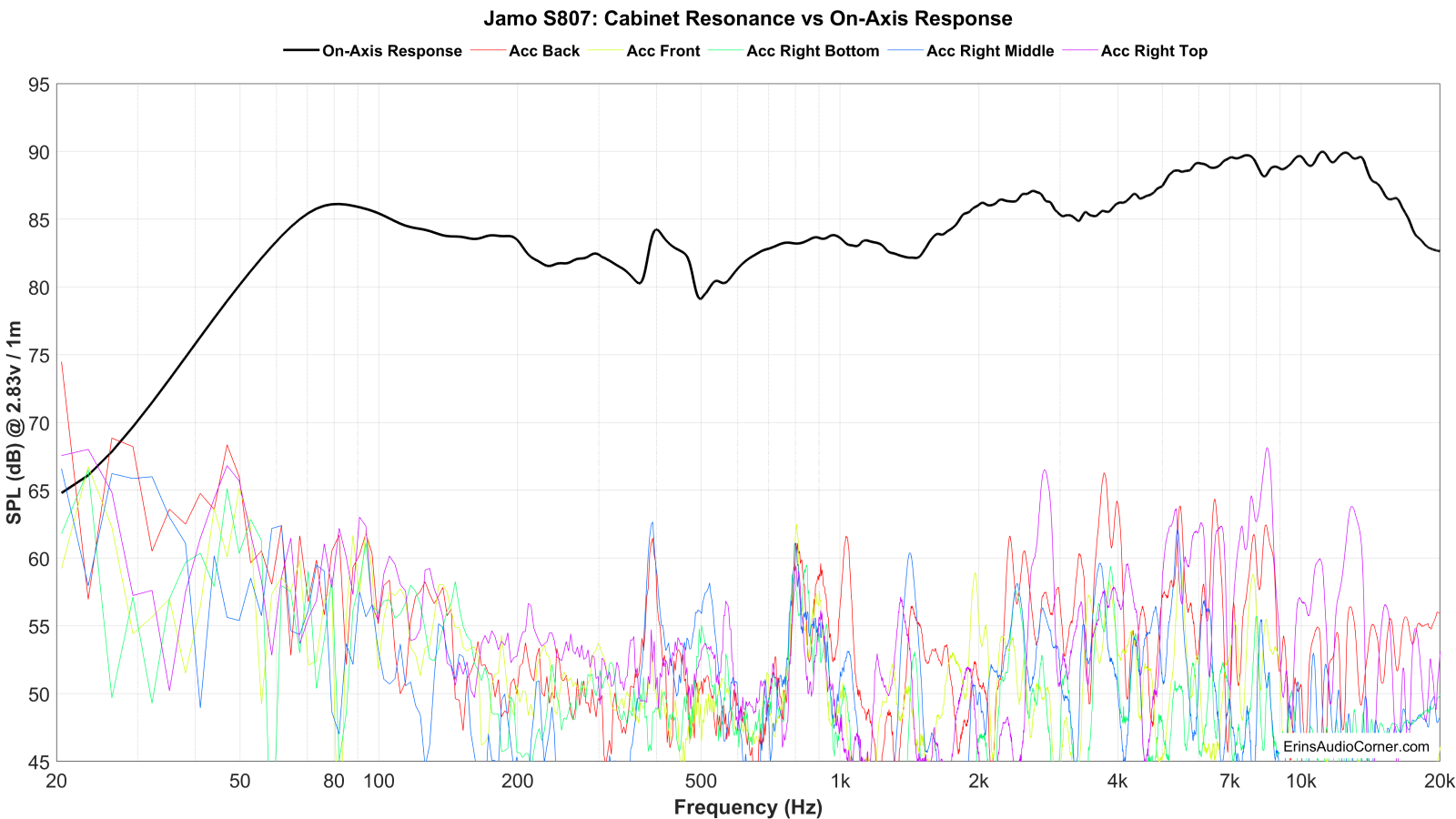
Since the accelerometer is not calibrated for voltage in the above graphic, I chose instead to view the results via a Sonograph, shown below. This shows a long decay for 800Hz - 850Hz. This seems to line up with a breakup mode of the port, shown in the next section.
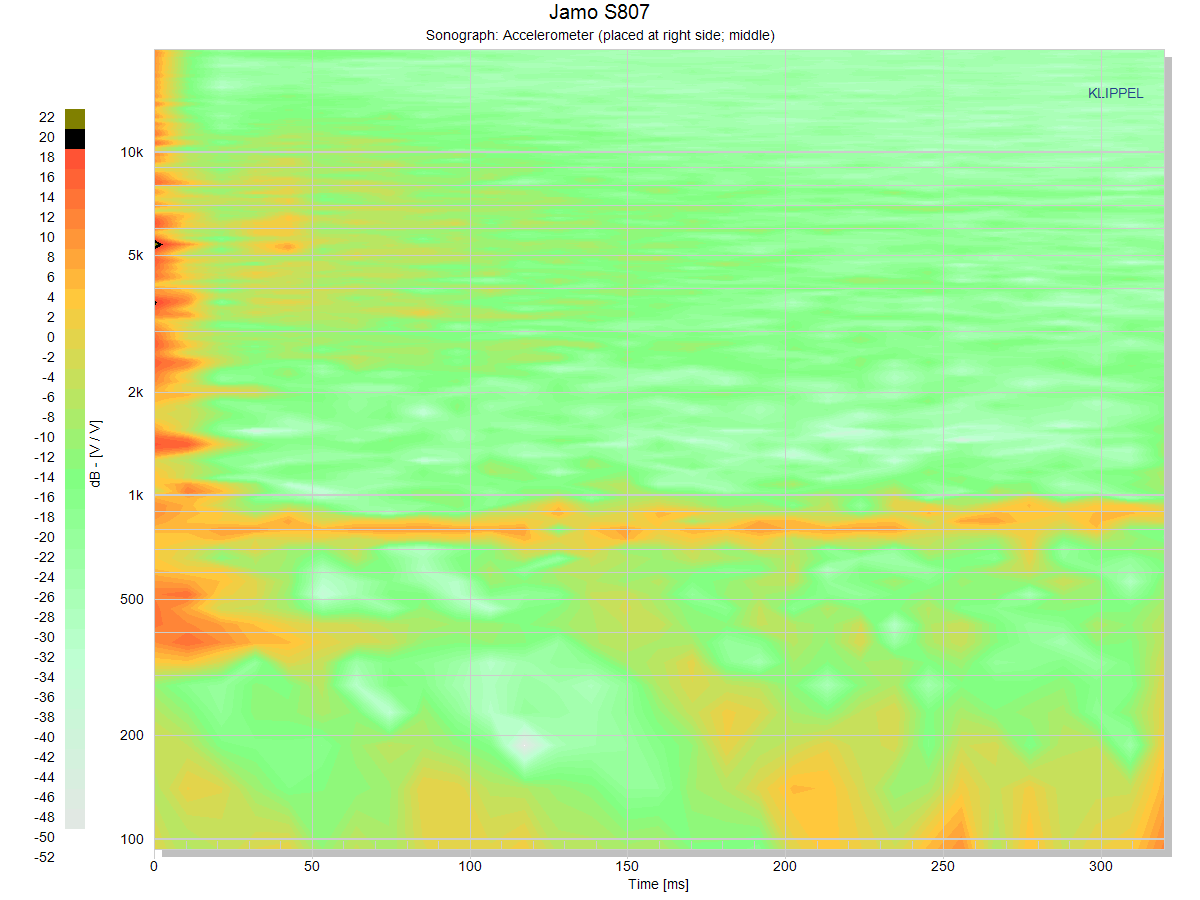
Nearfield measurements.
Mic placed about 0.50 inches from each drive unit and port. While I tried to make these as accurate in SPL as I could, I cannot guarantee the relative levels are absolutely correct so I caution you to use this data as a guide but not representative of actual levels (measuring in the nearfield makes this hard as a couple millimeters’ difference between measurements can alter the SPL level). Got it? Good.
There are a few noteworthy things here:
- Notice how quickly each woofer rolls off on the upper end. As if the crossover point used is lower than typical (maybe a shallower slope but lower crossover point?). This makes the transition from mid to tweeter bad.
- The tweeter shows a resonance around 6kHz.
- The port has a few areas of concern: peak at 200Hz, 400Hz, 600Hz and 850Hz. When you look at the overlaid farfield response (black) you can see the clear influence of port noise on the speaker’s response.
- The 5-inch woofers’ breakup modes cause resonance around 1.5kHz to 3kHz and apparently from 4-5kHz.
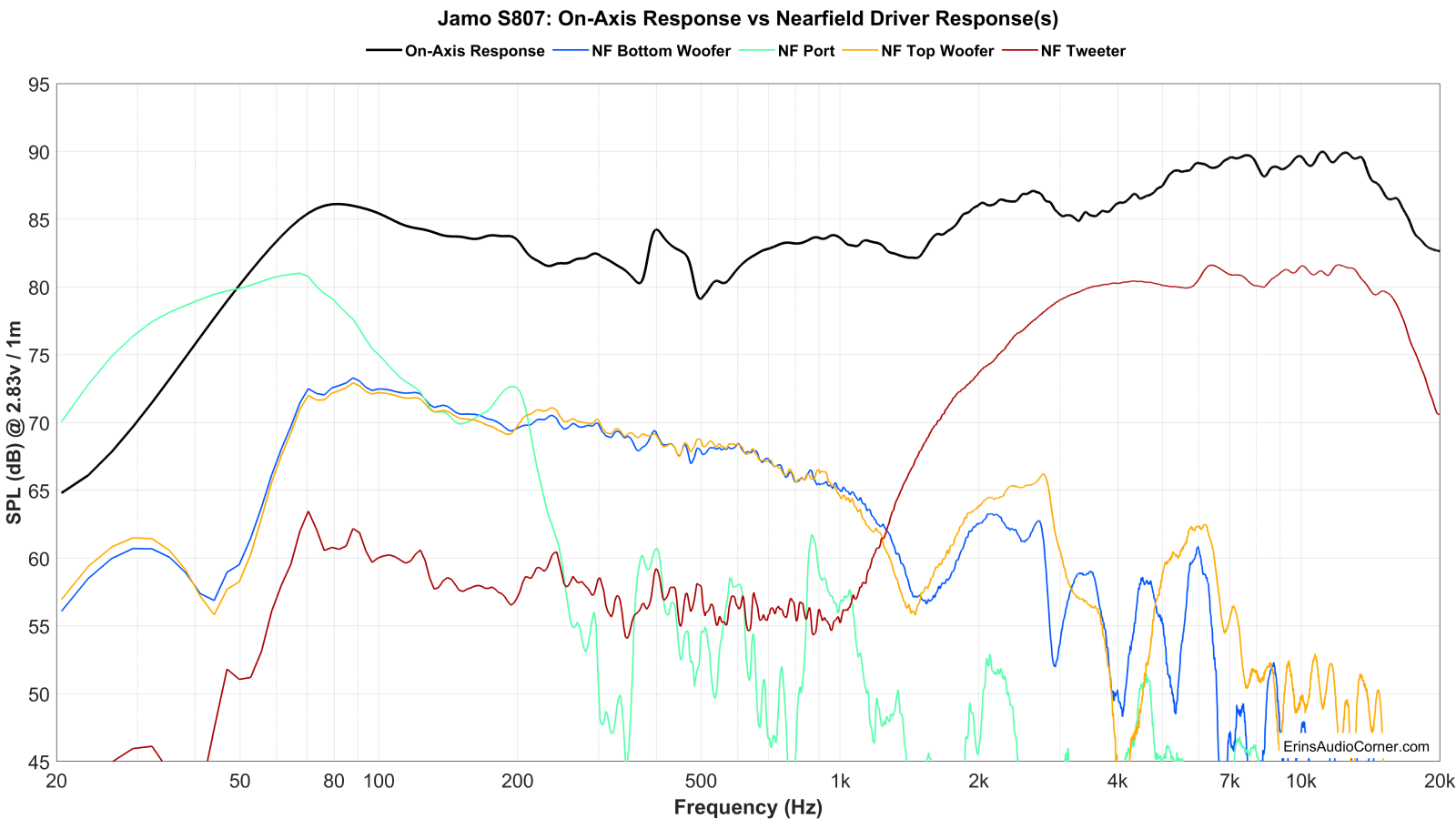
Step-Response.
One not zoomed and one zoomed.
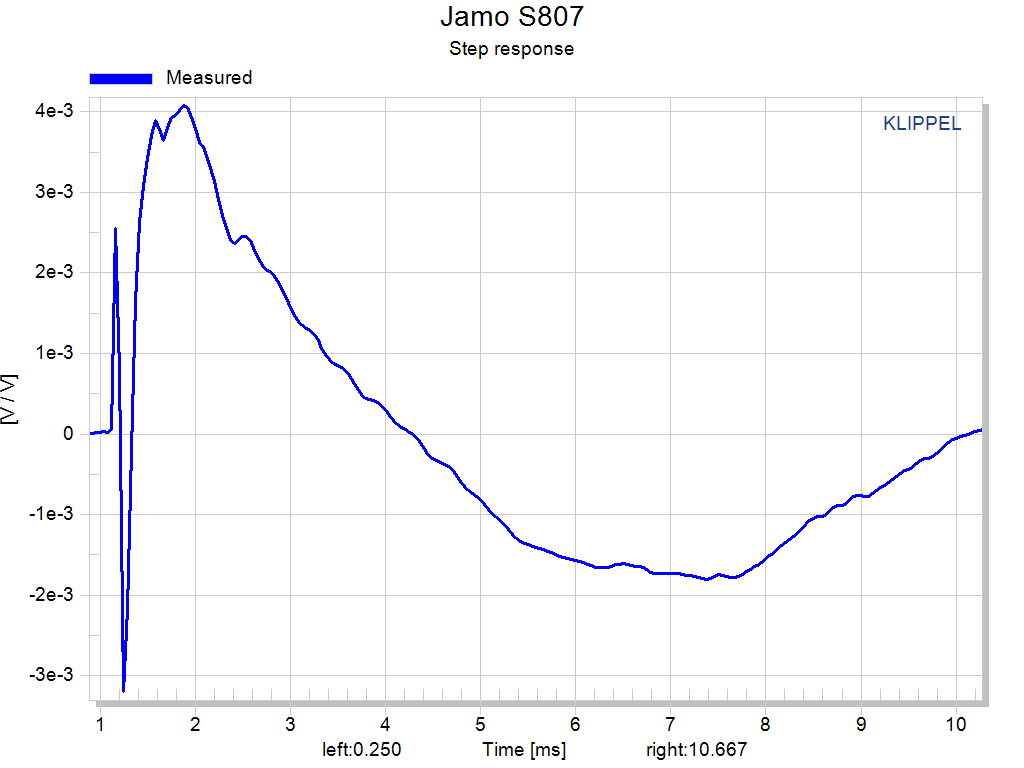
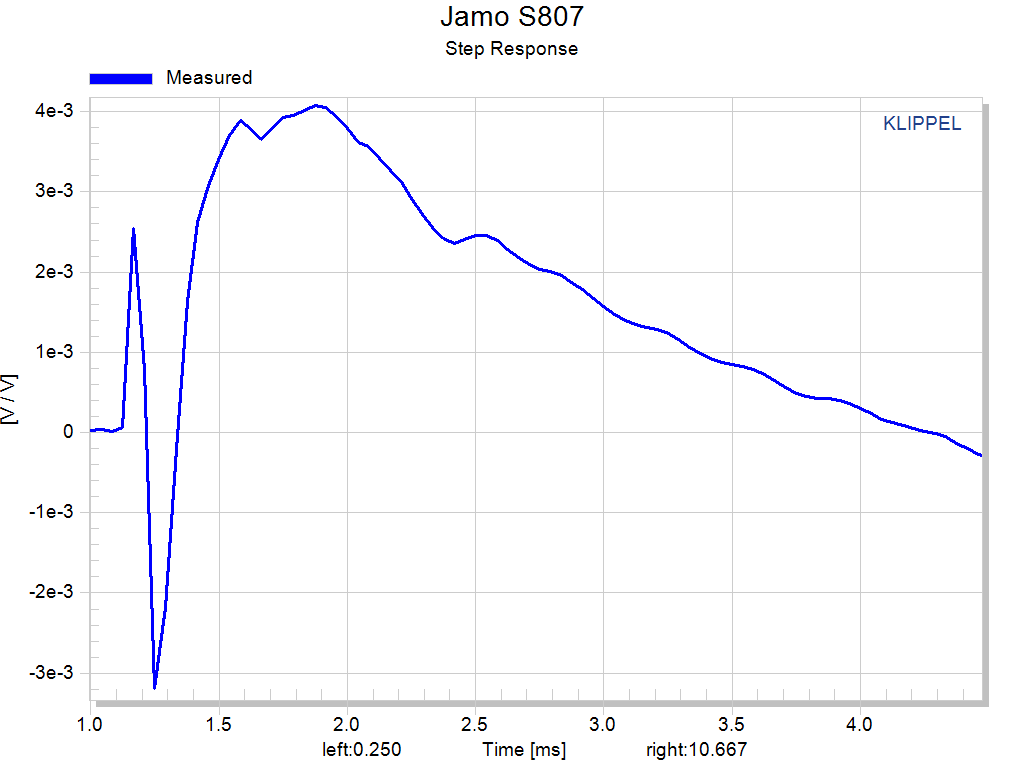
Objective Evaluation:
Much of what I am about to say I have already touched on under the data. But to recap:
Impedance:
- Minimum load of about 7.1 Ohms. Easily driven by most AVRs.
- Wiggles around 400Hz indicate resonance which also shows up in frequency response.
Frequency Response/Spectrograms/Globes/Spinorama:
- Terrible linearity. This is the first speaker I have tested with such a wild variation in frequency response. The response curve looks like a smiley face: lows and highs but no midrange. This will probably grab people’s attention and to those who don’t know what a high fidelity speaker should sound like it may sound awesome: it grabs your attention with the bass bump around 80Hz and with the overly-exaggerated high frequency response. But after a couple minutes you begin to realize just how bad it is.
- Jamo’s site states this speaker has a sensitivy of 90dB @ 2.83v/1m. I measured an average of 84.2dB @ 2.83v/1m. They must be using the 7kHz+ region to get their numbers.
- Jamo claims a ±3dB window of 42Hz - 26kHz. I measured a ±3dB response from 53Hz - 5kHz but only if you ignore the dip in response between 350-600Hz.
- Numerous resonances; most caused by the port. These show up at ~200Hz and 400Hz.
- The 5-inch woofers’ breakup modes cause resonance around 1.5kHz to 3kHz and also apparently from 4-5kHz.
- Multiple directivity shifts caused by poor crossover and resonances.
- Large tweeter results in a narrow directivity above 13kHz.
Distortion/Compression:
- High distortion at 40Hz but understandable given woofer size.
- Unacceptable levels of compression at high output below 100Hz.
- These are both audible effects when listening full-range as I did.
Subjective Evaluation:
Before I dive in to using hyperlatives (hyperbole + superlatives) let me first give you the layout of my room…
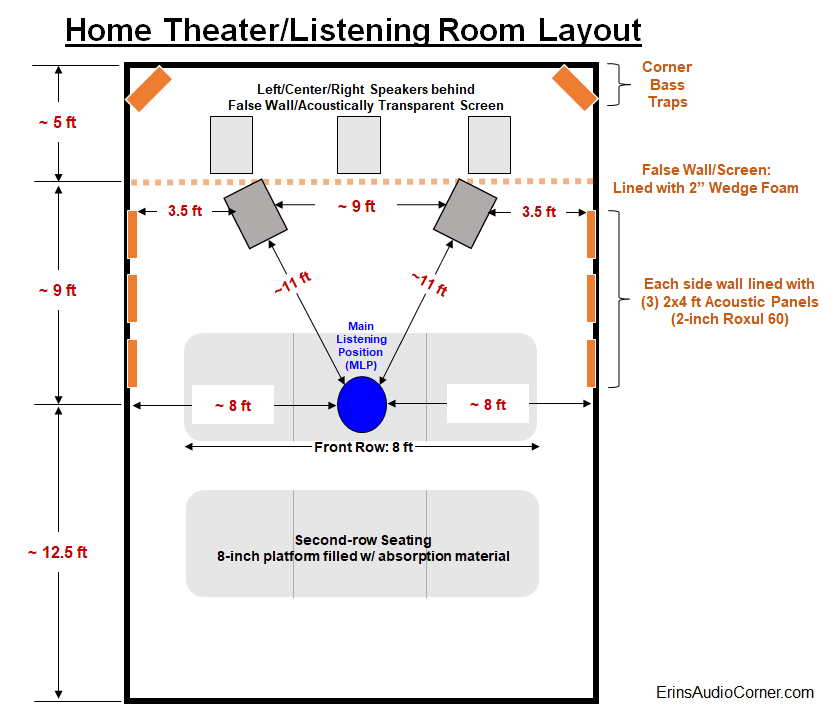
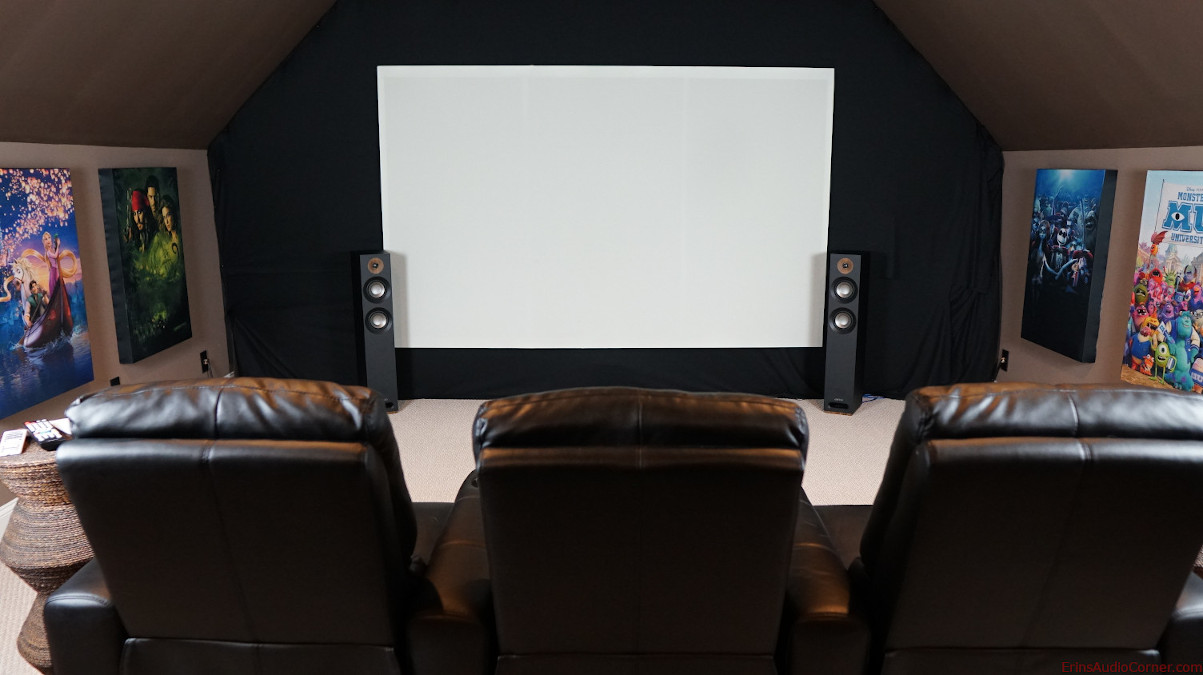
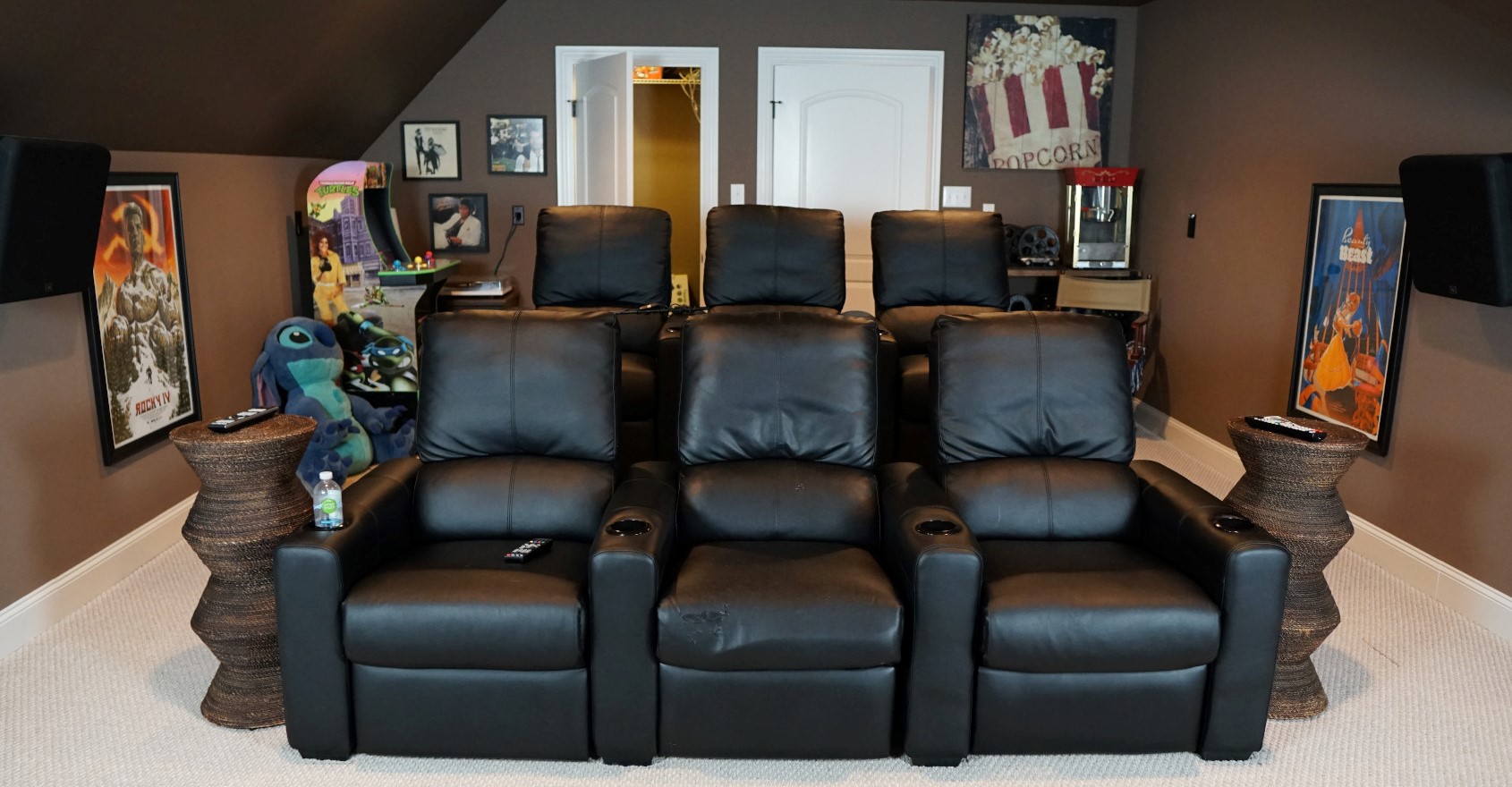
If the false wall part is odd to you, here's some background. I don't like seeing speakers when watching a movie. So, I built a false wall and used an acoustically transparent screen with speakers behind it. The wall is only 2x4's; no panels of wood or anything. Just a skeleton of a wall to give me something to attach the screen and acoustic treatment to. There is 2-inch wedge foam affixed to the 2x4 studs and between the false wall and back of the room are the front speakers (L/C/R & 18-inch subwoofers).
My demo music:
| Title | Artist | Album |
|---|---|---|
| Let It Whip | Dazz Band | 20th Century Masters: The Best Of Dazz Band |
| These Dreams | Heart | Heart (MFSL) |
| Cherry Bomb | John Cougar Mellencamp | The Lonesome Jubilee |
| I Don’t Care Anymore | Phil Collins | Hello, I Must Be Going! |
| Enjoy The Silence | Depeche Mode | Best Of Depeche Mode, Vol. 1 |
| Higher Love | Steve Winwood | Back In The High Life (MFSL UDCD-611) |
| 24K Magic | Bruno Mars | 24K Magic |
| Magic | The Cars | Heartbeat City (MFSL) |
| Something About You | Level 42 | The Very Best Of |
| Everlasting Love | Howard Jones | The Best of Howard Jones |
| Everybody Wants To Rule The World | Tears for Fears | Songs from the Big Chair (2014 Deluxe Edition - Disc 1) |
| Head Over Heels/Broken | Tears for Fears | Songs from the Big Chair (2014 Deluxe Edition - Disc 1) |
| Know Your Enemy | Rage Against The Machine | Rage Against The Machine (Hybrid SACD) |
| You’re My Best Friend | Queen | A Night at the Opera |
| Heartbreaker | Pat Benatar | In the Heat of the Night (DCC) |
| Doo Wop (That Thing) | Lauryn Hill | The Miseducation of Lauryn Hill |
| The Way You Make Me Feel | Michael Jackson | Bad |
| You Don’t Mess Around With Jim | Jim Croce | 24 karat Gold In A Bottle (DCC) |
Note: I don’t generally audition speakers with the typical “audiophile” music. I have thousands of high-quality albums ranging from pop to metal to jazz and all around. I don’t typically listen to “audiophile” music because I just don’t enjoy it. It is far more important that your evaluation music be something you are familiar with than it is to be esoteric for the sake of being esoteric. You also want to listen to music you enjoy because auditioning a stereo system shouldn’t feel like a chore. Such is the case in my evaluations. Besides, the subjective evaluation is purely to help tie to the objective data and make sense of what I am hearing to help you all get an understanding of how relevant the data is. As you will see below, my music selection did a great job at providing enough range for me to identify the issues that readily appear in the data.
Subjective Analysis Setup:
- The speaker was aimed on-axis with the tweeter at ear level.
- I used Room EQ Wizard (REW) and my calibrated MiniDSP UMIK-1 to get the volume on my AVR relative to what the actual measured SPL was in the MLP (~11 feet from the speakers). I varied it between 85-90dB, occasionally going up to the mid 90’s to see what the output capability was. In a poll I found most listen to music in this range. Realistically, 90dB is loud for long-term listening volume and I find most overestimate their listening volume until an SPL microphone is used to determine the actual level.
- All speakers are provided a relatively high level of Pseudo Pink-Noise for a day or two - with breaks in between - in order to calm any “break-in” concerns.
- I demoed these speakers without a crossover and without EQ.
I listened to these speakers and made my subjective notes before I started measuring objectively. I did not want my knowledge of the measurements to influence my subjective opinion. This is important because I want to try to correlate the objective data with what I hear in my listening space in order to determine the validity of the measurement process. I try to do a few listening sessions over a couple days so I can give my ears a break and come back “fresh”. I also want to be as transparent to you as I can be so below are my subjective evaluations made before I began any measurements.
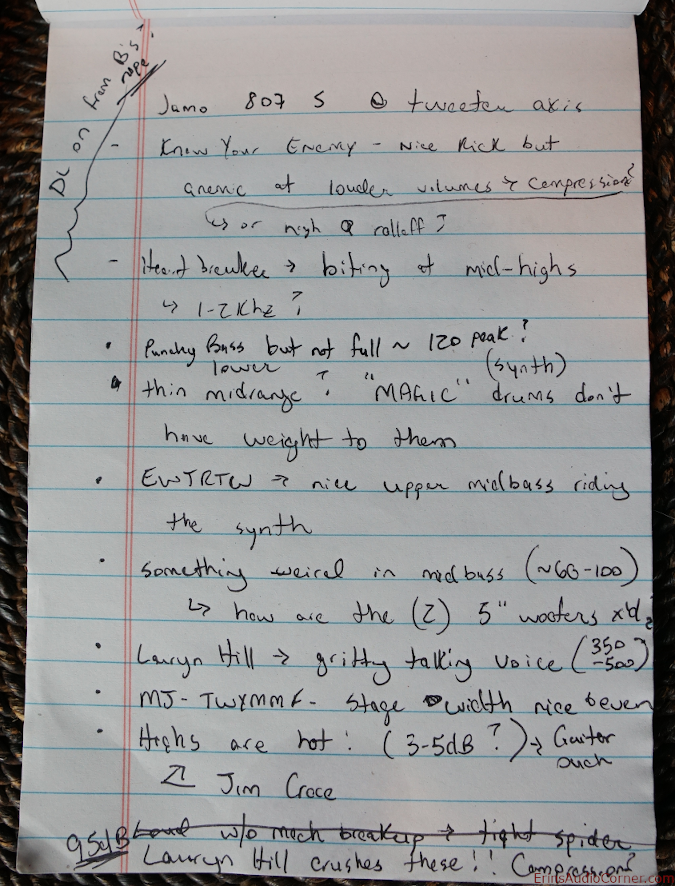
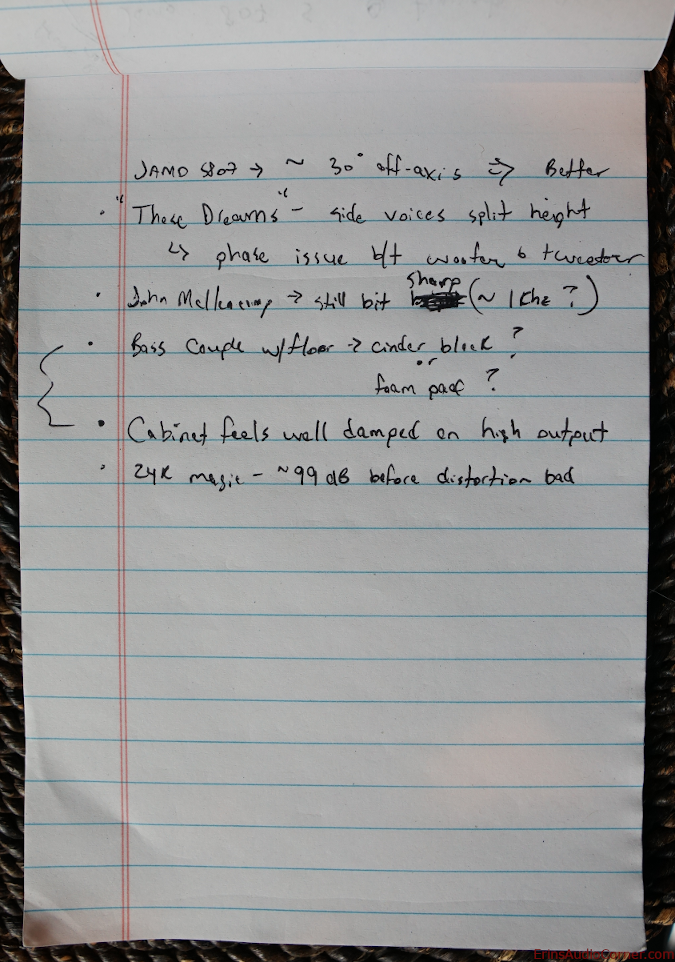
You may notice that I am more descriptive of frequencies than sounds. Many reviewers will quantify their evaluation discussing how a tone sounded or an instrument sounded. My history has always been in relating the sounds to frequencies so I can understand where I need to EQ. So, I’m no good at telling you a cello didn’t sound like it should with a certain fellow of a certain weight playing it. I just go off relative sounds, basically evaluating performance by “How does this frequency sound compared to another”. But I use this method along with this Interactive Frequency Chart and it works out in the end.
Let’s look again at the measured in-room response I provided above. Notice how well it matches the predicted in-room response.

Here’s the rundown of my subjective notes (in quotes) and where it fits with objective:
- Overall, I found the max SPL I could drive the speakers to was around 95-98dB at my listening position, depending on the music. That’s loud. But once I got past this point the compression was very audible and all the dynamics went away. This was most evident on the opening bass notes of Lauryn Hill’s song. It was very evident that I had reached the “brick wall” output here, even though the woofers weren’t mechanically falling apart like I would have expected.
- I kept noting things about the treble… “biting mid-highs”, “highs are hot! (3-5dB?)”. Well, sure enough, when you look at the objective measurements and what I measured in the room vs the Predicted In-Room Response it is easy to see why I made those notes. The high frequency response is as much as 5dB higher than the Target Response curve. The high frequencies are also as much as 6dB higher than the midrange response. This is a significant difference and will absolutely be audible even to untrained ears.
- This note got me: “Lauryn Hill -> gritty talking voice (350-500?)”. Looking at the data there is a clear resonance around 400Hz. I am sure this is what I was hearing.
- “Thin Midrange?”… yep, the data shows that as well. Again, the difference in midrange levels versus high frequency levels is as much as 6dB in some areas. And the 200Hz - 1kHz region is 3-5dB lower than the bass and treble. That will result in a very “thin” midrange sound because this low level is sandwiched right between two relatively high levels of output.
- “Know Your Enemy - Nice Kick but anemic at louder volumes. Compression or high Q rolloff?”. Both. The kick drum fundamental is typically around 50-100Hz (I don’t know the exact frequency in this particular song but the note is a general takeaway). What gives “fullness” to the kickdrum is the 100-250Hz region. Look at the frequency response. Notice how the response shows a bump around 80Hz? The response then trends downward from 100-200Hz to approximately 2dB below 80Hz at 200Hz. This is noticeable and relates to the fullness I noted.
- “These Dreams - side voices split height -> phase issue b/t woofer and tweeter?”. Normally when you have a “split stage” (where a single note sounds like it is coming from two different drive units) that is almost always a sign that the crossover region is bad. Usually it is a phase issue, where the tweeter and midrange are some degree apart from each other (maybe 180°, maybe 90°). I think I was hearing the issue with the midwoofers rolling off early and the data backs this up.
- “Cabinet feels well damped on high output”. I tested this with the accelerometer at both 2.83vRMS and 7vRMS (not pictured above) and didn’t find any noticeable results as I increased the input voltage to the speaker. In fact, the accelerometer data indicated less issues at higher voltage and that’s when I began to suspect a noise floor issue and decided to switch to the Sonograph view.
I also turned the speakers to be about 30° off-axis to see if I could get rid of the harsh treble. That didn’t help much at all and when you view the data you can see the off-axis response has low directivity around 4kHz (meaning, the sound is more omnidirectional at this frequency) which indicates the bright 4kHz region would be noticeable through a wider region of angles. I believe this explains the “biting” noise I was hearing as well.
I did not choose to pursue any further analysis with this speaker. It’s a bad performer. Not worthy of Dirac, in my humble opinion.
Bottom Line
This one is easy: If you are trying to achieve a high-fi stereo setup on a budget, these are not what you want. I recommend you save your money until you can find a more suitable replacement. These speakers provide two things: punch at about 80Hz only and annoying high frequencies. These are not high-fidelity by any metric. They make sound. That’s it.
I am fully aware that one argument for these speakers is that they have 2 woofers and therefore negate the need for a subwoofer. However, that is not the case. Due to the high amplitude compression, these speakers will need a proper subwoofer to provide meaningful output in the lower octaves (not just the lowest octaves). The bass has a peak around 80Hz which will give it a punchy sound but there is no “meat” to kick drums because the response varies nearly 5dB from 80Hz to 200Hz. The harmonics of that 80Hz peak are subdued and don’t allow the 80Hz sound to have the fullness that it otherwise would have.
The treble is greater than 5dB higher than the midrange output. Unfortunately, thanks to the directivity mismatches and resonances, a simple tonal balance either via EQ or the “treble” knob on your receiver will not solve the issues found in the high frequency range. Remember, you are listening to the culmination of sounds in a room: not just a single axis response. When you look at the other axes’ response relative to the on-axis response there are numerous areas where the sound becomes directional both horizontally and vertically. This creates mismatches in what you hear first (the direct, on-axis sound) and what is reflected (Early Reflections).
The End
If you like what you see here and want to help me keep it going, there’s a PayPal Contribute button at the bottom of each page. I pay for most test subjects out of my own pocket and donations help me pay for new test items, hardware to build random things like test stands, lunch, a dose of sanity, etc. Every little bit is truly appreciated.
You can also join my Facebook and YouTube pages via the links at the bottom of the page if you’d like to follow along with updates.
Thanks!

